
We are excited to have launched the MOST WANTED edition of the Altova MissionKit today! The MissionKit 2010 represents the most wanted functionality as reported by you! We’ve wrangled over 70 new features into this version of Altova’s XML, database, and UML product line to deliver on your list of demands. Check out the highlights for each product included in the MissionKit 2010 tool suite below; subsequent posts will cover the new features in each product in greater detail.
WSDL 2.0
One of the features most often asked for is support for the latest version of WSDL: WSDL 2.0. In addition to existing WSDL 1.1 editing and validation capabilities, XMLSpy now supports WSDL 2.0 in the graphical WSDL editor. It also allows one-click conversion between WSDL 1.1 and 2.0 files. 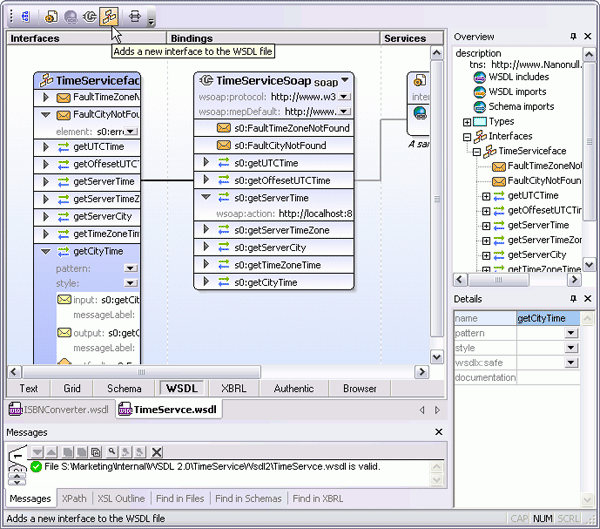
WSDL 2.0 support has also been added to version 2010 of the MapForce data mapping tool, allowing you to connect to WSDL 2.0 (or 1.1) Web services and integrate their functionality into mappings of XML, databases, flat file, EDI, Excel 2007, and XBRL data. You can also use MapForce to build new Web services based on WSDL 2.0 definitions. MapForce 2010 delivers a number of other enhancements for data mapping, conversion, and integration.
XBRL Enhancements
Several new features for working with XBRL have been added in version 2010. XMLSpy includes a new XBRL Taxonomy Wizard for getting a head start creating taxonomies in the graphical XBRL Taxonomy Editor. You can also now generate comprehensive documentation for your XBRL taxonomies, or simply print the graphical XBRL representation. Find and sort capabilities let you work more easily with large, complex taxonomies.
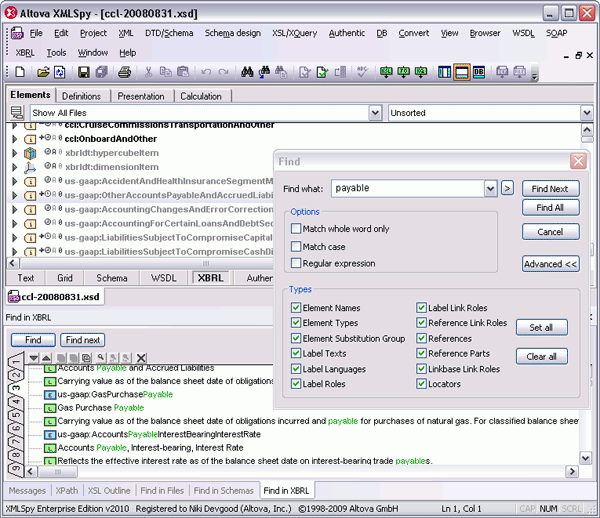
If you’re not familiar with the extensive support for working with XBRL in the Altova MissionKit, check out the XBRL Solutions Center page.
JSON Support
With more and more developers working with JSON in the XML, AJAX, and Web services apps they’ve created in XMLSpy, we’ve received a lot of inquires about JSON support. Now you can edit your JSON files directly in XMLSpy, using Text View or the graphical Grid / Tree View with intelligent JSON entry helpers. XMLSpy even supports one-click JSON <=> XML conversion. Check out the rest of the features most desired by XMLSpy users.
New Design Paradigm in StyleVision
The StyleVision graphical stylesheet design / single source publishing tool now gives you a new, flexible option for designing stylesheets and electronic forms. The new design paradigm lets you create templates within layout containers, and even optionally upload a blueprint image on which to base your design. This way, you can specify your design first and add XML and/or database content after.
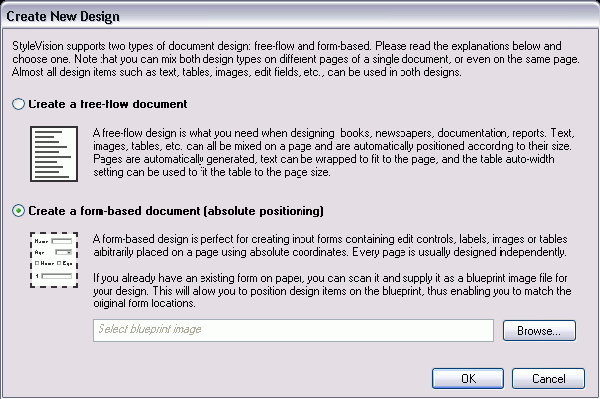
This new form-based design option is made possible by new support for absolute positioning in design layouts. Instead of having content and layout elements flow on the page automatically, like a typical web page layout, you can now specify exact X and Y coordinates for each element to absolutely position it on a page. This feature gives you more control over form design in the manner of desktop publishing applications, but also adds the powerful single source publishing capabilities for XML, XBRL, and database data that have always been present in StyleVision. Read about the numerous other enhancements in StyleVision 2010. Authentic 2010 users will directly benefit from many of the new StyleVision features for true electronic forms design described above. The sophisticated e-Forms created in StyleVision 2010 are presented in Authentic’s WYSIWYG-interface for XML and database content editing by non-technical business users. In addition, with the release of Version 2010, Authentic is now offered in Enterprise and Community Editions, both of which are available as either as a desktop application or browser plug-in. The new Authentic 2010 Enterprise Edition requires a paid license and provides advanced features for WYSIWYG XML and database content editing. Authentic 2010 Browser Plug-in Enterprise Edition is offered on a 12 month license term basis. Authentic 2010 Community Edition is available under a free license and is also offered in desktop and browser plug-in versions.
SysML Support
Altova’s affordable UML modeling tool has become even more robust with support for SysML, which is related to UML but optimized for designing software to operate and control embedded systems and other complex devices. UModel 2010 supports all SysML v1.1 diagram types and elements with all the same productivity-enhancing features available for UML and BPNM modeling, including code generation in Java, C#, and Visual Basic.
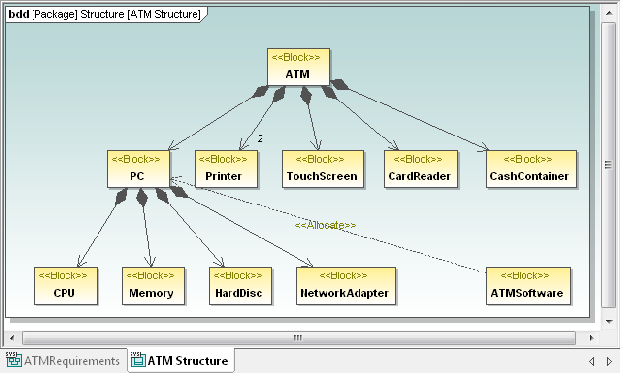
Read about all the new features in UModel 2010.
New Diff/Merge Capabilities
Both DatabaseSpy and DiffDog have received some exciting and oft-requested new diff/merge features in version 2010. DatabaseSpy, the highly-affordable, multi-database query, design, and comparison tool now allows you to compare and merge database schemas between databases of the same type or across different database types (all major relational databases are supported). DatabaseSpy displays differences between database schemas in a graphical manner, and you can generate a change script to merge changes in either direction.
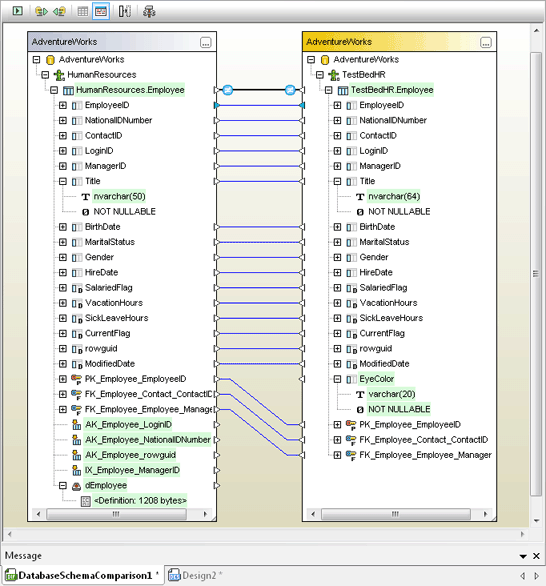
DatabaseSpy 2010 also adds the ability to convert database structures between different database types, for example, to migrate from MySQL® to Oracle® or SQL Server®. Version 2010 of the DiffDog diff/merge tool for files, directories, and databases includes functionality similar to DatabaseSpy for comparing and merging database schemas, and it also provides the most wanted XML Schema diff feature. Since XML Schemas are ever-evolving as requirements change, existing XML files often also need to be updated to remain valid. You can now compare two XML Schemas graphically in DiffDog 2010, and then DiffDog will generate an XSLT file to transform any related instance documents according to the new schema. Alternatively, you can choose to generate an Altova MapForce mapping file based on the DiffDog comparison to further refine the transformation
between schemas.


Collect your Handsome Reward
If you’re an Altova customer with active Support and Maintenance Package, simply download and install version 2010, and your existing key code will activate the new version. New customers can download a free, fully-functional 30-day trial to start working with all these new features today.
Altova XBRL Resources… just in time for XBRL US
With the XBRL US conference just around the corner, it’s high time to brush up on your knowledge. Fortunately, the Altova Web site has everything you need to learn the intricacies of XBRL vernacular, XBRL taxonomy structure, how XBRL relates to XML, XBRL reporting, and more. Altova XBRL Resources
So, check out these resources, download a free 30-day trial of the MissionKit, grab a cup of coffee, and start exploring XBRL today… and don’t forget to stop by our booth next week at XBRL US in Philly!
Introducing XMLSpy 2011 Chinese Language Edition
We are thrilled to announce that with the release of Version 2011, XMLSpy is now available in a Chinese language edition. The new fully localized Chinese edition of the XMLSpy XML editor provides the same powerful functionality found in the English, German, and Japanese versions for editing, transforming, and debugging XML-related technologies. With the release of Version 2011 XMLSpy also adds ground-breaking new support for creating eye-catching charts based on XML data, making it the first and only XML editor on the market to support chart creation. XMLSpy 2011 also delivers several new customer-requested features, including a new schema flattener, extended SOAP validation capabilities, and enhanced functionality for creating schemas. For our current XMLSpy 2011 customers you can unlock any language version using your existing key code. If you’re not an XMLSpy user download a free trial of XMLSpy 2011 to begin using all of the powerful new functionality available in Version 2011. Our decision to bring the localizations services in-house demonstrates our commitment to the Chinese market, and allows us to pass that cost savings on to you, our customers. The Chinese language version of Altova XMLSpy 2011 is currently available in Professional and Enterprise Editions and is available for purchase now from the Altova Online Shop or through your preferred reseller. XMLSpy 2011中文版本推出 我们很激动地宣布2011版本的发布,XMLSpy现在已有中文版可用,新的完全本地化的中文版XMLSpy XML编辑器如今可以提供英语,德语和日语多语种的编辑,转换和调试XML相关的技术,随着2011年的版本,我们还增加了突破性的基于XML数据创建醒目图表的支持,使之成为商场上第一个和唯一一个支持图表创建的XML编辑器,除此以外,我们还添加了多个客户要求的功能,这些功能包括新模式拼合,扩展的SOAP验证和为创建模式增进的功能。
For our current XMLSpy 2011 customers you can unlock any language version using your existing key code. If you’re not an XMLSpy user download a free trial of XMLSpy 2011 to begin using all of the powerful new functionality available in Version 2011. Our decision to bring the localizations services in-house demonstrates our commitment to the Chinese market, and allows us to pass that cost savings on to you, our customers. The Chinese language version of Altova XMLSpy 2011 is currently available in Professional and Enterprise Editions and is available for purchase now from the Altova Online Shop or through your preferred reseller. XMLSpy 2011中文版本推出 我们很激动地宣布2011版本的发布,XMLSpy现在已有中文版可用,新的完全本地化的中文版XMLSpy XML编辑器如今可以提供英语,德语和日语多语种的编辑,转换和调试XML相关的技术,随着2011年的版本,我们还增加了突破性的基于XML数据创建醒目图表的支持,使之成为商场上第一个和唯一一个支持图表创建的XML编辑器,除此以外,我们还添加了多个客户要求的功能,这些功能包括新模式拼合,扩展的SOAP验证和为创建模式增进的功能。  XMLSpy 2011当前的用户可以使用现有的键码解锁全部语言的版本,如果您还不是我们的用户,您可以下载免费试用版本,开始尝试2011版的强大新功能。 我们的本地化决定证明了我们致力于对中国市场的决心,使我们有机会帮助用户来节约成本,价格从136欧元或15232人民币起,标准,专业和企业版都具备中文版本,您可以通过Altova网店或其他首选经销商购买。
XMLSpy 2011当前的用户可以使用现有的键码解锁全部语言的版本,如果您还不是我们的用户,您可以下载免费试用版本,开始尝试2011版的强大新功能。 我们的本地化决定证明了我们致力于对中国市场的决心,使我们有机会帮助用户来节约成本,价格从136欧元或15232人民币起,标准,专业和企业版都具备中文版本,您可以通过Altova网店或其他首选经销商购买。
Visit Altova at DevConnections
StyleVision® & Multi-channel Publishing (yup, we've got that covered too)
Ah, StyleVision… it really is so many different things packed into one powerful application. Stylesheet designer, report builder, eForms designer, and multi-channel publisher, with additional supporting features like charting, Authentic® scripting, and XBRL reporting – it sometimes seems like it does everything short of Vulcanian mind-melds (coming in SD 7411.4). But, for the here and now, let’s focus on multi-channel publishing. Multi-channel publishing is the ability to use a single source of information to provide enterprise content that can be formatted for delivery to different channels like Web, intranet, and traditional print. This methodology can be easily integrated into existing publishing technologies and workflows to maintain overall production value without disrupting the flow of day to day business processes. StyleVision even expands on its multi-channel publishing support with the ability to base publishing templates on multiple disparate data formats including XML, DTD, XBRL, and database source(s). This means that your templates can integrate data from multiple XML sources, or even combine data from an XML Schema and a relational database. In fact, you can even create designs to publish XML documents stored inside relational database columns (currently supported for IBM DB2 and SQL Server only). Multiple Output Formats The StyleVision design interface lets you visually create templates for multi-channel output in HTML, RTF, PDF, Word 2007+, and Authentic® eForms. Using drag-and-drop and advanced entry helper windows, you can easily create an attractive and functional template design for distribution to virtually any modern publishing medium.
StyleVision autogenerates standards-conformant XSLT 1.0/2.0 and XSL:FO stylesheets based on your template design to instantaneously publish your source content into the target output format of your choice. Simply click on the relevant output tab on the design pane to render your data at any time. You can even view or save the generated transformation code.
Building Business Reports To create a multi-channel publishing template in StyleVision, simply open an existing XML Schema, XML instance, DTD, XBRL taxonomy, or database, and the content model will appear in the Schema Tree entry helper. You can even connect to multiple XML and database schemas to incorporate data from multiple sources – such as an XML file and a database – in your design. When you select an element or attribute that you wish to see in your report and drag it from the Schema Tree window onto the design pane, StyleVision prompts you to specify how you would like the new node to be handled (for example, as a new paragraph, image, table, etc.). This information will be rendered dynamically based on the data in your source(s). You can also insert static content such as header text, images, hyperlinks, and so on. StyleVision also offers an alternative design paradigm for those more accustomed to working with common desktop publishing applications. For more information, see the Electronic Forms Design page. The StyleVision interface provides advanced entry helper windows for viewing, editing, and assigning the style and layout properties of each element or document section in your report design. Learn more about this functionality on the Stylesheet Designer page. To meet the specific rendering requirements of XBRL financial reports, StyleVision includes an easy to use XBRL Table Wizard. Learn more about this feature on the XBRL Rendering page. Conditional Templates Conditional templates add to StyleVision’s multi-channel publishing capabilities, enabling you to apply advanced dynamic functionality to your design. Conditional templates are based on XPath expressions and allow you to design forms with layout and presentation that changes based on source data in the XML file(s) or database. Advanced publishing protocols like output-based conditions enable you to display multi-channel content differently depending on its delivery format. Conditions for specific output can be placed around individual parts or components of the document, thus providing considerable flexibility in the way the different output documents are structured. For example, HTML output may require functionality like hyperlinks or special instructions that are not necessary for print output. Content Editing StyleVision designers can also easily create and distribute electronic forms for editing using Authentic, Altova’s low cost XML and database content editor. Together, these two applications provide an easy-to-use and powerful content editing framework that lets developers create a robust data entry application that can publish output to multiple channels. For more information, see the Authentic Forms Design section. Functions Multi-channel publishing templates designed in StyleVision support advanced functionality such as auto-calculations, business logic validation, and much more. Read more about advanced stylesheet functions. Charts & Graphs StyleVision also supports creating detailed multi-channel documentation with visual representations such as charts and graphs. As with all StyleVision designs, charts can be rendered for multi-channel output in HTML, RTF, PDF, Word 2007+, and as electronic forms. For more information, see the Charts & Graphs feature page. Check out StyleVision and add true flexibility to your business documentation with powerful support for multi-channel publishing. Download a free 30-day trial of today!
StyleVision also offers an alternative design paradigm for those more accustomed to working with common desktop publishing applications. For more information, see the Electronic Forms Design page. The StyleVision interface provides advanced entry helper windows for viewing, editing, and assigning the style and layout properties of each element or document section in your report design. Learn more about this functionality on the Stylesheet Designer page. To meet the specific rendering requirements of XBRL financial reports, StyleVision includes an easy to use XBRL Table Wizard. Learn more about this feature on the XBRL Rendering page. Conditional Templates Conditional templates add to StyleVision’s multi-channel publishing capabilities, enabling you to apply advanced dynamic functionality to your design. Conditional templates are based on XPath expressions and allow you to design forms with layout and presentation that changes based on source data in the XML file(s) or database. Advanced publishing protocols like output-based conditions enable you to display multi-channel content differently depending on its delivery format. Conditions for specific output can be placed around individual parts or components of the document, thus providing considerable flexibility in the way the different output documents are structured. For example, HTML output may require functionality like hyperlinks or special instructions that are not necessary for print output. Content Editing StyleVision designers can also easily create and distribute electronic forms for editing using Authentic, Altova’s low cost XML and database content editor. Together, these two applications provide an easy-to-use and powerful content editing framework that lets developers create a robust data entry application that can publish output to multiple channels. For more information, see the Authentic Forms Design section. Functions Multi-channel publishing templates designed in StyleVision support advanced functionality such as auto-calculations, business logic validation, and much more. Read more about advanced stylesheet functions. Charts & Graphs StyleVision also supports creating detailed multi-channel documentation with visual representations such as charts and graphs. As with all StyleVision designs, charts can be rendered for multi-channel output in HTML, RTF, PDF, Word 2007+, and as electronic forms. For more information, see the Charts & Graphs feature page. Check out StyleVision and add true flexibility to your business documentation with powerful support for multi-channel publishing. Download a free 30-day trial of today!
New Feature : Authentic® Scripting in StyleVision®
StyleVision has really benefited from some very cool new features in our past and current releases – absolute positioning, editable variables in eForms, global templates, and of course, charting, bring power and flexibility to your report generation and electronic forms designs. Now with our 2011 release, the addition of an integrated scripting environment expands on these features, giving you the ability to create robust data entry applications for Authentic users. Scripting functionality is embedded directly into the StyleVision design (SPS) so that Authentic end-users only need to open an eForm to start updating XML and database sources. Event handler and macro components can be written using supported scripting languages, JavaScript or VBScript, and you can also design input forms graphically using drag and drop functionality. To embed scripting functionality in a StyleVision design (SPS), open the Scripting Editor window via the Authentic | Edit Authentic Scripts menu command or by choosing Authentic Script from the Design tab context menu.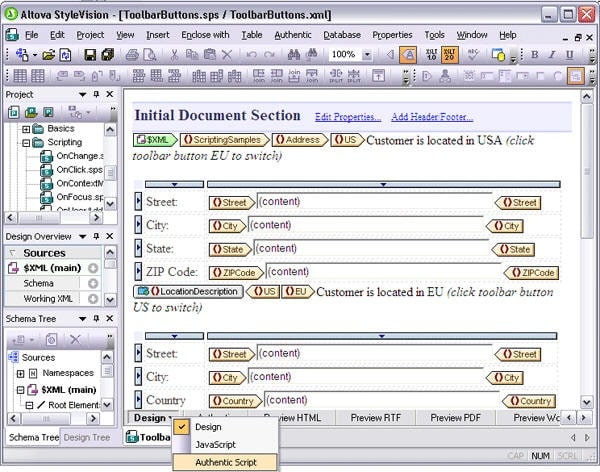 The Scripting Editor provides an interface through which you can create any of the following four main components:
The Scripting Editor provides an interface through which you can create any of the following four main components:
Global Declarations The GlobalDeclarations component is presented by default in every scripting project. Variables and functions are added using code fragments written in the scripting language (JScript or VBScript) associated with your project. An example function, StartChangingAddress, appears below: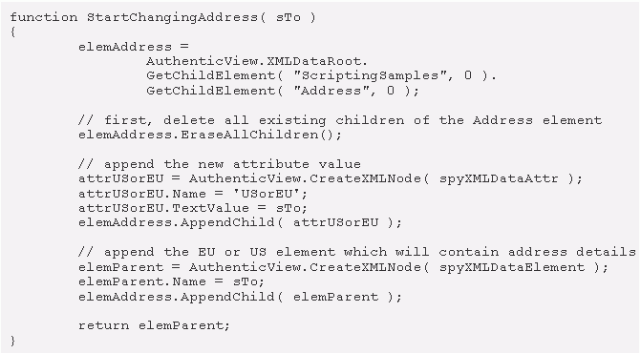 Variables or functions created in the global declarations script are accessible to all forms, event handlers, and macros in your scripting project. Macros Macros let you create functions that are called from other scripts or event handlers. For example, the macro shown below uses the GlobalDeclarations, including the StartChangingAddress function, to create a form for adding information to an active XML document.
Variables or functions created in the global declarations script are accessible to all forms, event handlers, and macros in your scripting project. Macros Macros let you create functions that are called from other scripts or event handlers. For example, the macro shown below uses the GlobalDeclarations, including the StartChangingAddress function, to create a form for adding information to an active XML document. 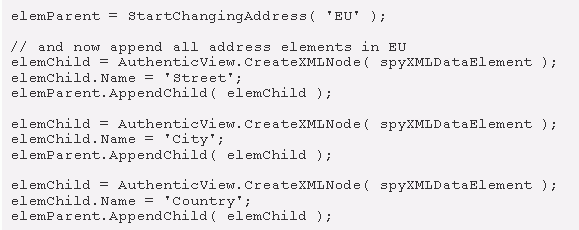 Macros can be specified and associated with StyleVision design elements using the Authentic group in the Properties window. Object events that are supported for macros are:
Macros can be specified and associated with StyleVision design elements using the Authentic group in the Properties window. Object events that are supported for macros are:
The scripting editor provides a folder which contains the full set of events for which event handler scripts can be written. Forms The Authentic Scripting Editor lets you graphically build forms using a palette of objects such as text input fields, buttons, labels, and more. General form properties such as size, background color, font styles, etc. are defined in the Properties pane.
Forms The Authentic Scripting Editor lets you graphically build forms using a palette of objects such as text input fields, buttons, labels, and more. General form properties such as size, background color, font styles, etc. are defined in the Properties pane.  The form object palette provides all of the objects that are available. Registered ActiveX controls can also be added by selecting the Add ActiveX Control command in the right-click menu.
The form object palette provides all of the objects that are available. Registered ActiveX controls can also be added by selecting the Add ActiveX Control command in the right-click menu.  Once an object has been inserted in your design, you can specify its appearance properties – such as alignment, borders, scroll bars, etc. – in the Properties pane.
Once an object has been inserted in your design, you can specify its appearance properties – such as alignment, borders, scroll bars, etc. – in the Properties pane.
Scripting in Practice
Authentic View scripting gives StyleVision designers complete and flexible control over various aspects of the user interface. In addition, extensions to the existing COM APIs add more flexibility for scripting and interactive eForm design. For example: Interactive object-specific design elements – such as the click of a button, modification of form elements, focus change between fields, etc. – can be accessed through the Authentic interface. User actions include OnClick, OnBeforeLinkClick, OnBeforeChange, OnAfterChange, OnSetFocus, and OnKillFocus. Entry helper windows can be suppressed to ensure that Authentic end-user access is limited only to modification of the intended elements, attributes, and entities. Context (right-click) menus can be completely customized by removing existing or adding new commands.
Entry helper windows can be suppressed to ensure that Authentic end-user access is limited only to modification of the intended elements, attributes, and entities. Context (right-click) menus can be completely customized by removing existing or adding new commands.  New toolbar buttons can be created and associated with macros, giving the designer the ability to add completely new commands to the toolbar.
New toolbar buttons can be created and associated with macros, giving the designer the ability to add completely new commands to the toolbar.  Custom and standard toolbars can be modified by disabling any buttons that the end-user should not have access to.
Custom and standard toolbars can be modified by disabling any buttons that the end-user should not have access to.  The COM API has also been extended with new interfaces and additional methods and properties including:
The COM API has also been extended with new interfaces and additional methods and properties including:
Check out all of this new functionality and more – download a free 30-day trial of StyleVision today!
MissionKit 2011 Now Available in Japanese
With the release of Version 2011 we are thrilled to bring you the Altova MissionKit in Japanese. Now all the Altova tools available in the MissionKit have been fully translated into Japanese. Like the English and German versions of the tool suite, the fully translated Japanese language version provides users with powerful functionality for XML and Web development, data mapping and integration, rendering and publishing of XML, XBRL, and database data, UML modeling, and more. All the tools available in the new Japanese language version of The MissionKit are available at the same cost as the English versions, and current Version 2011 users can now unlock any language version using their existing key code. If you haven’t checked out our latest release – Version 2011, download a free, 30-day trial today! The Japanese language version of all the MissionKit tools can be purchased from the Altova Online Shop or through your preferred reseller.
If you haven’t checked out our latest release – Version 2011, download a free, 30-day trial today! The Japanese language version of all the MissionKit tools can be purchased from the Altova Online Shop or through your preferred reseller.
Altova Receives ‘2010 Best of Beverly’ Award
We are proud to announce that Altova was selected for the “2010 Best of Beverly” award in the Computer Software Development category by the U.S. Commerce Association (USCA)! The USCA “Best of Local Business” award program recognizes outstanding local business throughout the country and each year identifies companies they believe have achieved exceptional marketing success in their local community and business category. We are proud to be recognized by our local community for our success in the software industry as well as for the contributions we’ve made to the local area, such as committing to use renewable energy. And be sure to check back often to learn more about what we’ve been up to, including the most recent software release – Altova MissionKit Version 2011 – to helpful Tech Notes, the latest industry buzz, and other Altova awards.
New Software Feature: Charting in DatabaseSpy 2011
Charting SQL Query Results A link in the Altova DatabaseSpy 2011 SQL Editor Results window toolbar opens the Chart Selection dialog to initiate data charting.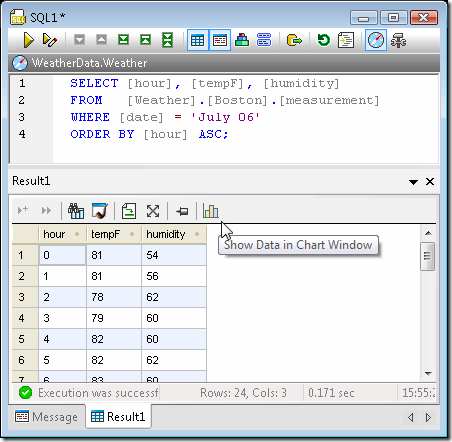 The chart tool icon opens the Select columns dialog, where users can specify which column of the Results table to use for the X-axis. Users can also change the order of value columns, or even leave one or more results column uncharted. This feature permits multiple charts to be generated for subsets of data from a single query that retrieves many table columns.
The chart tool icon opens the Select columns dialog, where users can specify which column of the Results table to use for the X-axis. Users can also change the order of value columns, or even leave one or more results column uncharted. This feature permits multiple charts to be generated for subsets of data from a single query that retrieves many table columns. 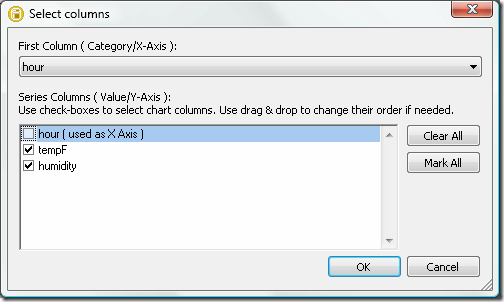 The data is initially plotted using the default chart type and settings in a new Charts window. Like other DatabaseSpy helper windows, the Charts window can be unpinned, moved, and resized, as a floating window. The Charts window has nine tabs that permit users to specify properties of nine different charts that can even be assigned to different query results.
The data is initially plotted using the default chart type and settings in a new Charts window. Like other DatabaseSpy helper windows, the Charts window can be unpinned, moved, and resized, as a floating window. The Charts window has nine tabs that permit users to specify properties of nine different charts that can even be assigned to different query results. 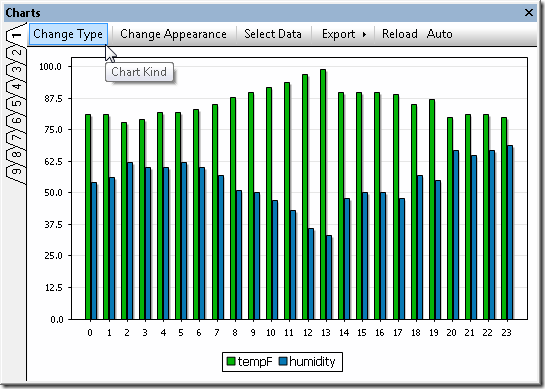 The Change Type dialog gives users instant access to a wide variety of other chart styles.
The Change Type dialog gives users instant access to a wide variety of other chart styles. 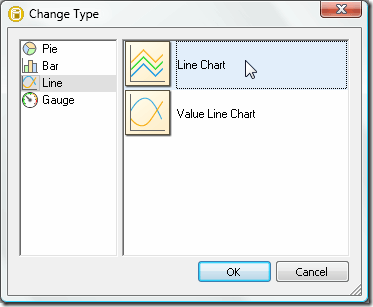 Within each chart type, sub-menus specify all the details of the chart appearance. Numerous customization options are available for each chart type, including chart titles, foreground and background colors, definition of axis ranges and labels, control of fonts, text colors and sizes, and more. A pull-down menu also lets users save and reload customized chart settings in files, for instance to store standardized chart styles and reuse them with multiple query results. The screenshot below shows a few of the settings for the line chart at the top of this page, which illustrates the same temperature and humidity data shown in the SQL query screenshot.
Within each chart type, sub-menus specify all the details of the chart appearance. Numerous customization options are available for each chart type, including chart titles, foreground and background colors, definition of axis ranges and labels, control of fonts, text colors and sizes, and more. A pull-down menu also lets users save and reload customized chart settings in files, for instance to store standardized chart styles and reuse them with multiple query results. The screenshot below shows a few of the settings for the line chart at the top of this page, which illustrates the same temperature and humidity data shown in the SQL query screenshot. 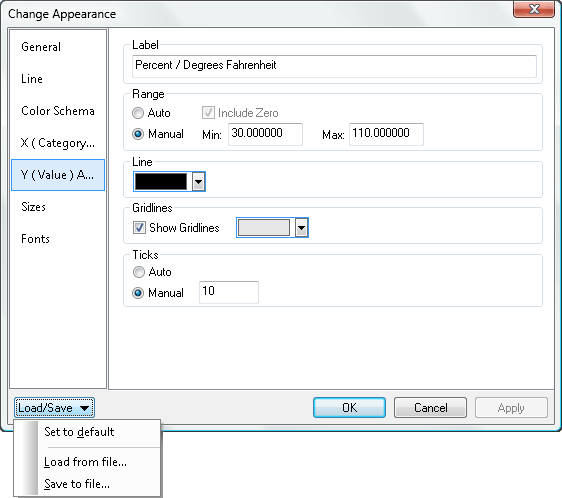 The screenshot below shows a bar chart reporting total sales for the year to date by sales territory. This is a typical example of a chart style that can be reused in a report that is frequently updated with the latest sales data.
The screenshot below shows a bar chart reporting total sales for the year to date by sales territory. This is a typical example of a chart style that can be reused in a report that is frequently updated with the latest sales data. 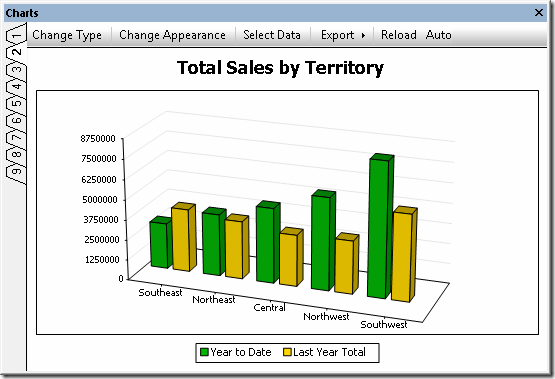 Multiple Charts from a Single SQL Query Results Table Generating multiple charts from the same SQL query is simple and straightforward by selecting different columns of data in the Results table. The SQL query in the screenshot below returns the population and land area of the boroughs that make up New York City:
Multiple Charts from a Single SQL Query Results Table Generating multiple charts from the same SQL query is simple and straightforward by selecting different columns of data in the Results table. The SQL query in the screenshot below returns the population and land area of the boroughs that make up New York City: 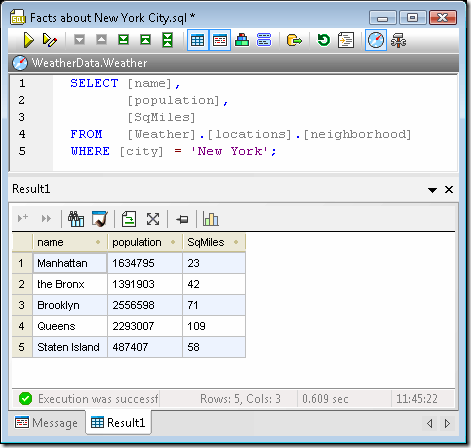 Users can choose any tab in the Charts window, then assign data by clicking the Select Data menu option in the Charts window menu bar.
Users can choose any tab in the Charts window, then assign data by clicking the Select Data menu option in the Charts window menu bar. 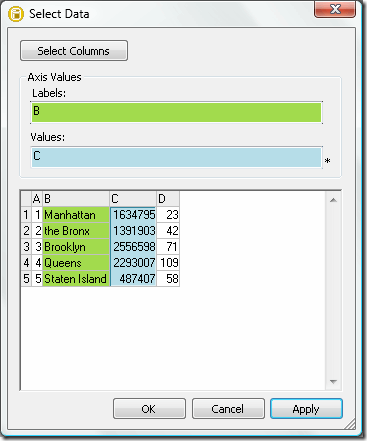 Here are examples of an ordinary pie chart and a 3-D pie chart generated individually from the population and square miles data columns of the Results table:
Here are examples of an ordinary pie chart and a 3-D pie chart generated individually from the population and square miles data columns of the Results table: 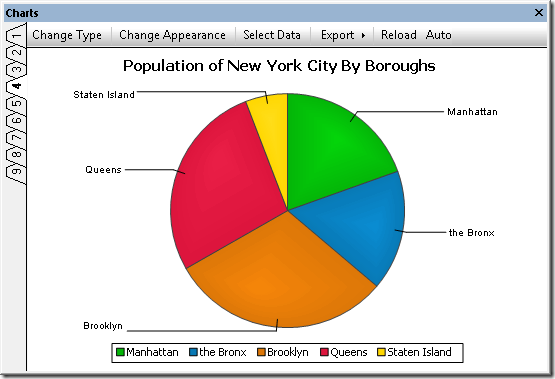
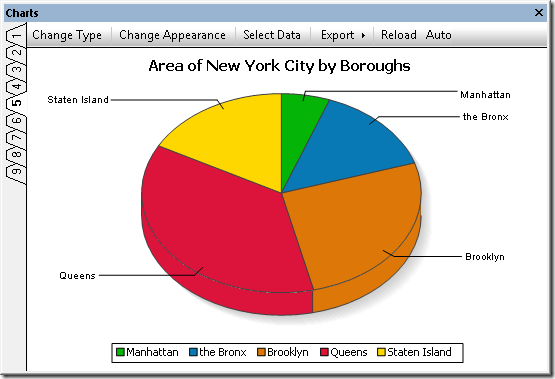 DatabaseSpy 2011 lets users change the chart colors by selecting an alternate palette or any custom colors.
DatabaseSpy 2011 lets users change the chart colors by selecting an alternate palette or any custom colors.  Gauge Charts from a Single Value or Calculated Results Gauge charts are used to illustrate a single value and show its relation to a minimum and a maximum value. For a round gauge chart, users can specify the beginning and ending values of the range, and the starting and ending locations on the gauge. DatabaseSpy 2011 enables complete gauge customization through selection of the background color, border color, needle color, text font, size, and color, and more.
Gauge Charts from a Single Value or Calculated Results Gauge charts are used to illustrate a single value and show its relation to a minimum and a maximum value. For a round gauge chart, users can specify the beginning and ending values of the range, and the starting and ending locations on the gauge. DatabaseSpy 2011 enables complete gauge customization through selection of the background color, border color, needle color, text font, size, and color, and more. 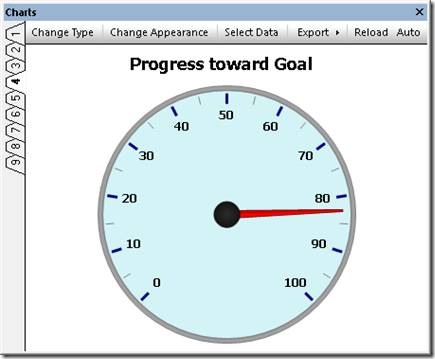 DatabaseSpy 2011 can generate charts from results tables that contain relational data, or from results of calculations performed by SQL queries. Gauge charts are a good fit for illustrating a single calculated value. The screenshot below shows a percent of quota calculation in a DatabaseSpy 2011 SQL Editor window, based on a table of stored daily sales and sales quota data.
DatabaseSpy 2011 can generate charts from results tables that contain relational data, or from results of calculations performed by SQL queries. Gauge charts are a good fit for illustrating a single calculated value. The screenshot below shows a percent of quota calculation in a DatabaseSpy 2011 SQL Editor window, based on a table of stored daily sales and sales quota data. 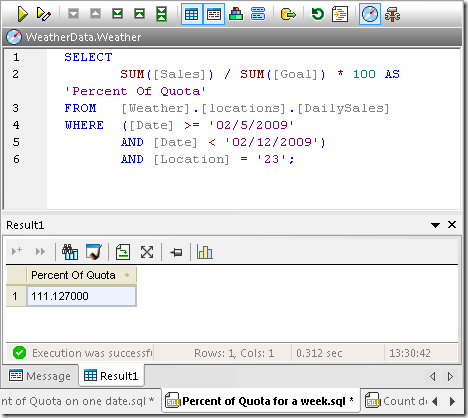 The calculated value can be more dramatic when represented in a bar gauge chart, where DatabaseSpy 2011 permits multiple background colors defined by ranges along the axis, as shown below.
The calculated value can be more dramatic when represented in a bar gauge chart, where DatabaseSpy 2011 permits multiple background colors defined by ranges along the axis, as shown below. 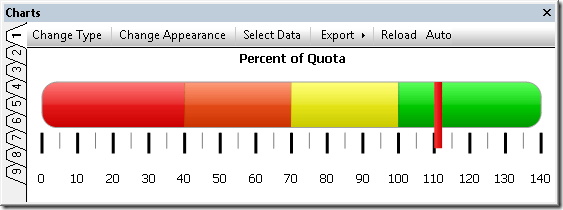 Export Charts for Reports DatabaseSpy 2011 exports charts to image files in .png, .bmp, .gif, or .jpg files in customized sizes, independent of the size of the chart window on the screen to create eye-catching visual elements in reports of all types.
Export Charts for Reports DatabaseSpy 2011 exports charts to image files in .png, .bmp, .gif, or .jpg files in customized sizes, independent of the size of the chart window on the screen to create eye-catching visual elements in reports of all types.  Whether you are a developer, business analyst, research professional, or other database user, DatabaseSpy 2011 can generate elegant charts from SQL query results to illustrate your data reports – download a free 30-day trial today!
Whether you are a developer, business analyst, research professional, or other database user, DatabaseSpy 2011 can generate elegant charts from SQL query results to illustrate your data reports – download a free 30-day trial today!
If you’d like to find out for yourself how well DatabaseSpy works with other Altova tools, download a free trial of the Altova MissionKit.
New Software Release : MapForce 2011
Chained transformations Support for chained transformations lets you create complex mappings where the output of one mapping becomes the input of another. This is a powerful feature that adds to MapForce’s ability to execute fully automated transformations. Each chained component becomes a modular entity in an interdependent transformation sequence, allowing for conversions to be made on-the-fly. You can create chained transformations using any number of mapping components connected to a final target component. Preview and code generation features can be displayed/generated for intermediate components, as well as for the final mapping result. Intermediate mapping components also now have a "pass-through" button in the title bar that lets you define the set of data that gets passed on to the following component.
For example, the mapping above shows a chained mapping where the pass-through button is active and sample data is assigned to component A. The output preview offers two separate sets of data: XML that conforms to the Contacts.xsd schema and incorporates a subset of data mapped from the Employees.xml sample file, and XML that conforms to PersonList.xsd using data from the Employees sample file. In both cases, the data has been amended with the relevant constants and functions that are shown in the MapForce design pane. Integration with StyleVision for output components Support for Global Resources throughout the MissionKit has already offered you some integration between Altova software applications… But this feature takes that integration to a whole new level, allowing you to render XML and XBRL output from your data mappings into HTML, RTF, PDF, and Word 2007+ using an associated StyleVision template design. This essentially combines MapForce’s any-to-any data mapping capabilities with a sophisticated rendering engine, meaning that you can now automate report generation from virtually any data format that can be mapped to an XML Schema or XBRL taxonomy. In the example below, a StyleVision design has been associated with the mapping by simply right-clicking the output file and browsing to select a suitable SPS file using the Component Settings dialog.
Integration with StyleVision for output components Support for Global Resources throughout the MissionKit has already offered you some integration between Altova software applications… But this feature takes that integration to a whole new level, allowing you to render XML and XBRL output from your data mappings into HTML, RTF, PDF, and Word 2007+ using an associated StyleVision template design. This essentially combines MapForce’s any-to-any data mapping capabilities with a sophisticated rendering engine, meaning that you can now automate report generation from virtually any data format that can be mapped to an XML Schema or XBRL taxonomy. In the example below, a StyleVision design has been associated with the mapping by simply right-clicking the output file and browsing to select a suitable SPS file using the Component Settings dialog.  Once the SPS file is entered or selected, you will be able to simply click on the relevant format tab (i.e., HTML, RTF, PDF, or Word 2007+) to view rendered data.
Once the SPS file is entered or selected, you will be able to simply click on the relevant format tab (i.e., HTML, RTF, PDF, or Word 2007+) to view rendered data. 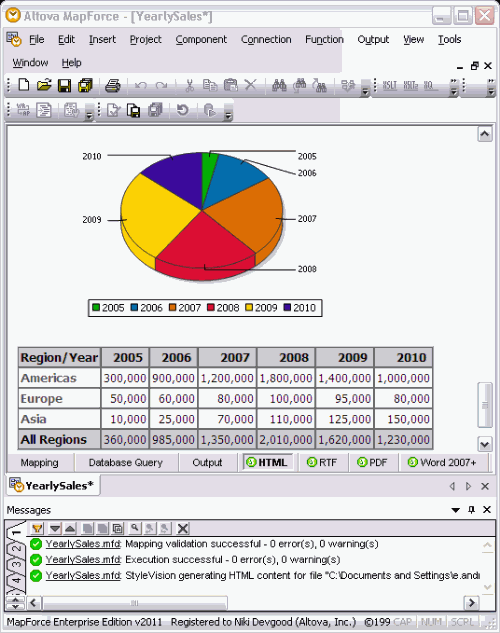 Formatting of numbers, dates, and times Probably one of the most requested features, this lets you easily convert numbers, dates, and times to their string representations using several different formatting functions. For example, the simple format-number function below converts a numerical input (e.g., 12345) to a monetary one in with a USD prefix, comma separating the thousands digits, and two decimal places (e.g., $12,345.00).
Formatting of numbers, dates, and times Probably one of the most requested features, this lets you easily convert numbers, dates, and times to their string representations using several different formatting functions. For example, the simple format-number function below converts a numerical input (e.g., 12345) to a monetary one in with a USD prefix, comma separating the thousands digits, and two decimal places (e.g., $12,345.00). 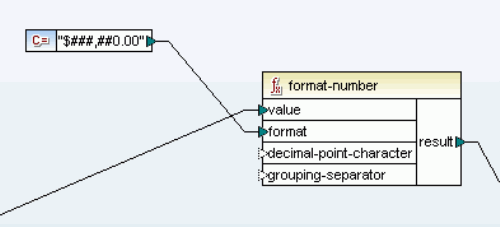 This post really just scrapes the surface of what the new MapForce release has to offer -download a free 30-day trial of Mapforce today to experience all of these new features and more!
This post really just scrapes the surface of what the new MapForce release has to offer -download a free 30-day trial of Mapforce today to experience all of these new features and more!
New Software Release : StyleVision 2011
On September 8, Altova released v2011 of the MissionKit with the addition of powerful reporting functionality across many of the products. Specifically, StyleVision has been supercharged with a multitude of new features, securing its place as an advanced and versatile business intelligence application, priced for today’s market. Let’s take a closer look at the exciting new features in StyleVision 2011 including:
Charts as a new design element StyleVision joins other MissionKit 2011 tools with support for charting, adding to its already advanced general purpose reporting capabilities to create a highly scalable decision support tool for XML, database, and XBRL content. As with all StyleVision designs, charts can be easily rendered for multi-channel output in HTML, RTF, PDF, Word 2007+, and electronic forms. The following types of charts are available:
The chart configuration dialog lets you use XPath to select data for your charts. This can be as simple or as complex as you want, running the gamut from database data that is already laid out in a tabular format to XML files where the nodes you need to select are spread out over hundreds of lines of code. Pssst… if you’re thinking that this would be great for the unique demands of XBRL, read on because we created something special with that in mind ;). Here are a couple of examples of charts that you can build in StyleVision:
 Yup, you can even chart completely different sets of data on the same graph. How creative you want to get with your visual analysis reports is really up to you. You can even create interactive charts for use with Authentic – allowing end users to manipulate eForms to view the desired result. For example, the screenshot below shows the Authentic view of a pie chart where a drop-down menu (combo box) selection dictates the subset of data that is represented.
Yup, you can even chart completely different sets of data on the same graph. How creative you want to get with your visual analysis reports is really up to you. You can even create interactive charts for use with Authentic – allowing end users to manipulate eForms to view the desired result. For example, the screenshot below shows the Authentic view of a pie chart where a drop-down menu (combo box) selection dictates the subset of data that is represented.  Charts are easily integrated into your StyleVision report templates at any point by simply dragging the relevant node onto the design pane and choosing Insert Chart from the context menu. The Chart Configuration dialog can then be used for chart settings (choosing chart type and style) and data selection (populating your chart axes with the relevant data from the source).
Charts are easily integrated into your StyleVision report templates at any point by simply dragging the relevant node onto the design pane and choosing Insert Chart from the context menu. The Chart Configuration dialog can then be used for chart settings (choosing chart type and style) and data selection (populating your chart axes with the relevant data from the source).  You can even use Dynamic XPath Settings to apply transactional data to your chart. Of course, if you sometimes have trouble telling your .s from your /s, you can always get some help with more complex expressions from StyleVision’s XPath Builder. Chart wizard for XBRL files If you are familiar with XBRL, you are intimately aware of the complexities associated with navigating XBRL taxonomies. And, if you’re impressed with what you’ve just read about StyleVision’s charting capabilities, you are probably trying to remember where you put that old XPath reference guide. Not to worry! StyleVision has added to its XBRL rendering support with an XBRL Chart Wizard that lets you easily select data and define presentation settings for your XBRL reports.
You can even use Dynamic XPath Settings to apply transactional data to your chart. Of course, if you sometimes have trouble telling your .s from your /s, you can always get some help with more complex expressions from StyleVision’s XPath Builder. Chart wizard for XBRL files If you are familiar with XBRL, you are intimately aware of the complexities associated with navigating XBRL taxonomies. And, if you’re impressed with what you’ve just read about StyleVision’s charting capabilities, you are probably trying to remember where you put that old XPath reference guide. Not to worry! StyleVision has added to its XBRL rendering support with an XBRL Chart Wizard that lets you easily select data and define presentation settings for your XBRL reports.  Concept and Period Properties dialogs are included to let you specify which elements should be included and how periods (instants or intervals of time) should be handled in your chart. Explicit support for HTML/CALS tables StyleVision now provides direct support for HTML/CALS tables, meaning that it will automatically recognize values dictating table structure (column number, row height, etc.) and apply them to rendered output. (v2011 adds support for rendering HTML/CALS tables in HTML, RTF, PDF, AND Word 2007+ – previous releases have supported output to Authentic eForms.)
Concept and Period Properties dialogs are included to let you specify which elements should be included and how periods (instants or intervals of time) should be handled in your chart. Explicit support for HTML/CALS tables StyleVision now provides direct support for HTML/CALS tables, meaning that it will automatically recognize values dictating table structure (column number, row height, etc.) and apply them to rendered output. (v2011 adds support for rendering HTML/CALS tables in HTML, RTF, PDF, AND Word 2007+ – previous releases have supported output to Authentic eForms.)  You can also easily assign additional presentation styles to HTML/CALS tables using the Edit CALS/HTML dialog.
You can also easily assign additional presentation styles to HTML/CALS tables using the Edit CALS/HTML dialog.  Ability to import existing XSLT files Well, I’m sure a few of you were hoping that this one was coming soon… You can now base your StyleVision template designs on existing XSLT files that were designed for HTML output or XSLT files with XSL:FO commands that were designed for output to PDF. Simply choose the New from XSLT File option and presto change-o, your design will be fully manifested in the design pane. Now you can edit your template using StyleVision’s graphical interface and output to even more formats (HTML, RTF, PDF, Word 2007+, and Authentic eForms) with just the click of a button. Scripting & toolbar editor for Authentic This feature is just way too cool not to devote an entire post to it, so keep your eyes peeled for a full description coming up on this blog. In the meantime, check out the Authentic scripting page for a brief description and examples. Better yet, just download a free 30-day trial of StyleVision today to test drive all of these new features for yourself!
Ability to import existing XSLT files Well, I’m sure a few of you were hoping that this one was coming soon… You can now base your StyleVision template designs on existing XSLT files that were designed for HTML output or XSLT files with XSL:FO commands that were designed for output to PDF. Simply choose the New from XSLT File option and presto change-o, your design will be fully manifested in the design pane. Now you can edit your template using StyleVision’s graphical interface and output to even more formats (HTML, RTF, PDF, Word 2007+, and Authentic eForms) with just the click of a button. Scripting & toolbar editor for Authentic This feature is just way too cool not to devote an entire post to it, so keep your eyes peeled for a full description coming up on this blog. In the meantime, check out the Authentic scripting page for a brief description and examples. Better yet, just download a free 30-day trial of StyleVision today to test drive all of these new features for yourself!
XMLSpy Version 2011
Creation of charts & graphs from XML data
Like several other tools in the MissionKit 2011, XMLSpy now supports chart and graph generation. Chart creation is unique to XMLSpy and brings a whole new dimension to working with data in an XML editor. Now you can visualize and analyze numerical XML data – and XBRL data – directly inside XMLSpy with just a few clicks. No more exporting to Excel! The following types of charts are available:
Below are two example charts that show just some of the possibilities for representing XML data in attractive, meaningful way – with just a few clicks:
 To create a new chart, simply highlight a range of data in Text View or Grid View, right click, and select New Chart. You can also specify the data to chart via XPath expression. Once you’ve used the Select Columns dialog to specify which data you want displayed, either via XPath or by highlighting it in the window, and how you want to display it….
To create a new chart, simply highlight a range of data in Text View or Grid View, right click, and select New Chart. You can also specify the data to chart via XPath expression. Once you’ve used the Select Columns dialog to specify which data you want displayed, either via XPath or by highlighting it in the window, and how you want to display it….  …you can choose the type if chart you require, and the appearance of the chart, from colors to fonts and more. You can create up to nine different charts on the available tabs in the Output Window, and you can save each as a custom-sized image file with just a click or print it directly from XMLSpy. You can also copy it to your clipboard to paste it in another application, such as Microsoft® Word or PowerPoint. One of the coolest aspects of these charts is that they’re totally dynamic. Once you make a change to the underlying XML data, the chart can be instantly regenerated, either automatically by hitting Reload, depending on your preference. What’s more, you can copy the XSLT or XQuery code to create the chart to the clipboard for use in your own stylesheet or application. The XSLT/XQuery code can be executed in XMLSpy and via AltovaXML 2011 Enterprise Edition, Altova’s XML standards processor. Chart support extends to the XMLSpy XSLT profiler and XQuery profiler, as well. After profiling an XSLT or XQuery execution, one click creates a chart to help you immediately visualize the results based on one or more criteria. This makes it easy to immediately interpret the results of a profiling an XSLT or XQuery execution or to communicate those results with other team members in a powerful, visual way.
…you can choose the type if chart you require, and the appearance of the chart, from colors to fonts and more. You can create up to nine different charts on the available tabs in the Output Window, and you can save each as a custom-sized image file with just a click or print it directly from XMLSpy. You can also copy it to your clipboard to paste it in another application, such as Microsoft® Word or PowerPoint. One of the coolest aspects of these charts is that they’re totally dynamic. Once you make a change to the underlying XML data, the chart can be instantly regenerated, either automatically by hitting Reload, depending on your preference. What’s more, you can copy the XSLT or XQuery code to create the chart to the clipboard for use in your own stylesheet or application. The XSLT/XQuery code can be executed in XMLSpy and via AltovaXML 2011 Enterprise Edition, Altova’s XML standards processor. Chart support extends to the XMLSpy XSLT profiler and XQuery profiler, as well. After profiling an XSLT or XQuery execution, one click creates a chart to help you immediately visualize the results based on one or more criteria. This makes it easy to immediately interpret the results of a profiling an XSLT or XQuery execution or to communicate those results with other team members in a powerful, visual way.
Validation of SOAP messages
Requested often by our customers, this new feature will be very useful for Web services developers, as it allows them to ensure their SOAP messages are valid against the SOAP specification as well as any XML Schemas referenced in the corresponding WSDL definition.
Schema flattener
The new schema flattener in XMLSpy 2011 allows schema designers to write all the dependent files that are included in a schema into one file. This way, you can use the flattened XML Schema without having to rely on a network connection to access the required files. This could be especially important when shipping a schema within an application.
Schema subset picker
Many schemas are quite large and contain more types and elements than are required for a particular application or information exchange. Furthermore, the larger a schema is, the longer loading and validation may take. The ability to create a new schema from a subset means a developer can select some global elements or types from a large schema to create a smaller one, using just the elements required. This feature is especially useful for working with NIEM information exchanges, but has also been requested by other users for a variety of applications. Read about all the features added to the Altova MissionKit tool suite or download the latest version now. If you’re a current customer with an active Support & Maintenance Package, you can update to v2011 for free.
Read about all the features added to the Altova MissionKit tool suite or download the latest version now. If you’re a current customer with an active Support & Maintenance Package, you can update to v2011 for free.
UML Database Modeling in UModel 2011
As software applications interact with growing amounts of data, database designs and structures become critical to development of successful projects. UModel® 2011, just launched on September 8, 2010, adds a new feature that empowers users to extend software modeling functionality by modeling relational databases along with Java, C#, and Visual Basic software applications. UModel 2011 accelerates database modeling with features that permits users to:
UModel Database Diagram Elements UModel 2011 database diagrams support all the following database elements:
Import Existing Database Structures Users can import an existing relational database via a selection in the UModel 2011 Project menu.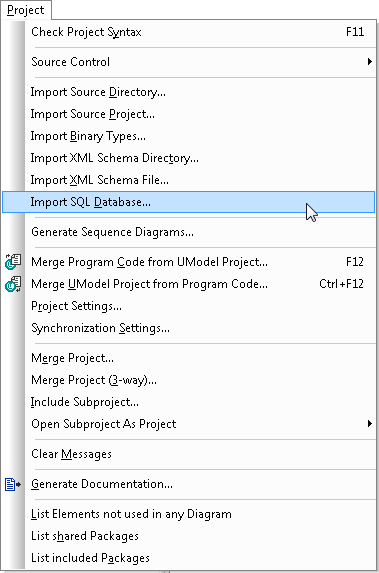 The Import SQL Database option opens the UModel 2011 Database Connection dialog, with the Database Connection Wizard and all the additional connection options available in DatabaseSpy and other Altova MissionKit tools that interact with popular relational databases.
The Import SQL Database option opens the UModel 2011 Database Connection dialog, with the Database Connection Wizard and all the additional connection options available in DatabaseSpy and other Altova MissionKit tools that interact with popular relational databases.  When importing a database, UModel 2011 also automatically adds a database profile to the project. UModel 2011 database diagrams are displayed in a special category in the Diagram Tree Helper window.
When importing a database, UModel 2011 also automatically adds a database profile to the project. UModel 2011 database diagrams are displayed in a special category in the Diagram Tree Helper window.  Modifying Databases in the Model UModel 2011 database diagrams use a dedicated toolbar with icons indicating database elements that are shared with DatabaseSpy, easing the learning curve between tools.
Modifying Databases in the Model UModel 2011 database diagrams use a dedicated toolbar with icons indicating database elements that are shared with DatabaseSpy, easing the learning curve between tools.  As editing proceeds in UModel 2011, the SQL Auto-completion helper window assists with creation of diagrams valid for the SQL database type.
As editing proceeds in UModel 2011, the SQL Auto-completion helper window assists with creation of diagrams valid for the SQL database type. 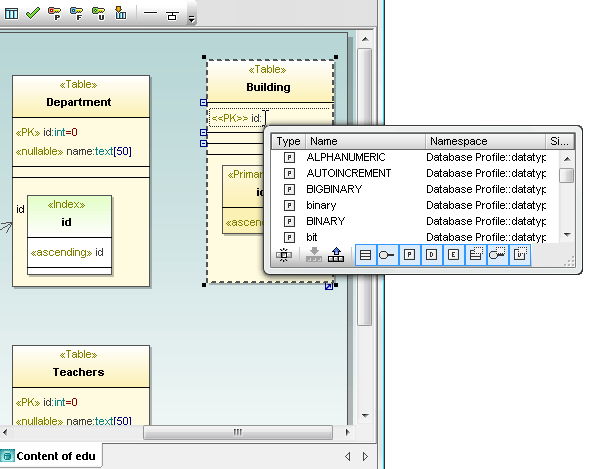 As an alternative to working directly in the diagram, users can also edit database elements in the Properties helper window.
As an alternative to working directly in the diagram, users can also edit database elements in the Properties helper window. 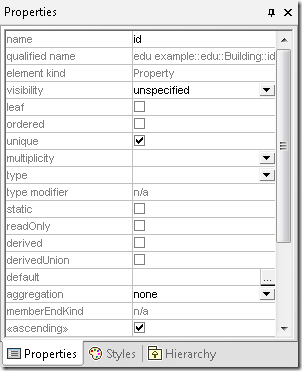 Database Change Scripts When a developer synchronizes program code from the UModel project, changes in any database diagram generate a Database Change Script with SQL commands to implement the revisions. Database Change Scripts created in UModel can be saved as SQL files, executed directly in the database, or opened in a DatabaseSpy SQL Editor window via a convenient button in the UModel Database Change Script dialog.
Database Change Scripts When a developer synchronizes program code from the UModel project, changes in any database diagram generate a Database Change Script with SQL commands to implement the revisions. Database Change Scripts created in UModel can be saved as SQL files, executed directly in the database, or opened in a DatabaseSpy SQL Editor window via a convenient button in the UModel Database Change Script dialog.  Conversely, if another team member modifies a table directly in the database, a developer can update the UML model by merging the database changes.
Conversely, if another team member modifies a table directly in the database, a developer can update the UML model by merging the database changes.  After synchronization of the UML model with the latest version of the database, the database diagram shows a new column in the Teachers table.
After synchronization of the UML model with the latest version of the database, the database diagram shows a new column in the Teachers table.  Like all other UModel diagram types, UModel 2011 lets users save database diagrams as image files and include them in automatically-generated project documentation. Visit the Altova What’s New page to learn more about all the new features in the Altova MissionKit 2011. Model databases along with system requirements, business rules, and application code for your next development project – click here to download a free 30-day trial of UModel 2011 today!
Like all other UModel diagram types, UModel 2011 lets users save database diagrams as image files and include them in automatically-generated project documentation. Visit the Altova What’s New page to learn more about all the new features in the Altova MissionKit 2011. Model databases along with system requirements, business rules, and application code for your next development project – click here to download a free 30-day trial of UModel 2011 today!
Altova MissionKit 2011 is Now Available!
CHARTS
Charts can now be generated and used in the MissionKit 2011 XML and database tools in a variety of ways. The following types of charts and graphs are available for providing a graphical representation of numerical data:
Charts are fully dynamic and can be automatically or manually regenerated when backend data is updated. XMLSpy You can create a new chart directly in the XML editor by simply highlighting a range of data in either Text View or Grid View and selecting New Chart from the right-click context menu.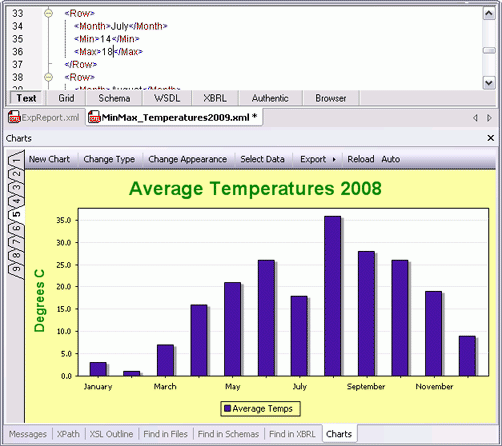 The chart’s appearance, labels, and so on, are highly customizable, and your finished chart can be printed, copied to the clipboard, saved as an image, or – and this is truly unique – exported as XSLT or XQuery code for use in your own stylesheets, reports, or apps.
The chart’s appearance, labels, and so on, are highly customizable, and your finished chart can be printed, copied to the clipboard, saved as an image, or – and this is truly unique – exported as XSLT or XQuery code for use in your own stylesheets, reports, or apps. 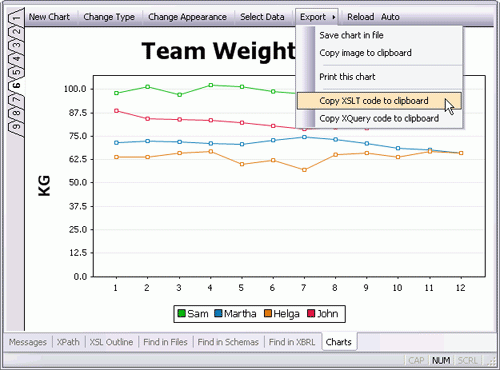 XMLSpy is the first and only XML editor on the market to support this powerful functionality, giving our users a distinct advantage when it comes to analyzing and interpreting XML data. You can also create a chart to visualize the results delivered by the XMLSpy XSLT Profiler and XQuery Profiler, making it easy to interpret and communicate performance data. StyleVision Charting and graphing support in StyleVision 2011, the stylesheet and report design tool, allows you to present data in a powerful, visual way, so that it can be easily analyzed from a variety of different angles. When you’re creating an XML, database, or XBRL report (or even a data entry form for use in Altova Authentic), it’s easy to specify your chart parameters via XPath and then customize the appearance of your chart or graph.
XMLSpy is the first and only XML editor on the market to support this powerful functionality, giving our users a distinct advantage when it comes to analyzing and interpreting XML data. You can also create a chart to visualize the results delivered by the XMLSpy XSLT Profiler and XQuery Profiler, making it easy to interpret and communicate performance data. StyleVision Charting and graphing support in StyleVision 2011, the stylesheet and report design tool, allows you to present data in a powerful, visual way, so that it can be easily analyzed from a variety of different angles. When you’re creating an XML, database, or XBRL report (or even a data entry form for use in Altova Authentic), it’s easy to specify your chart parameters via XPath and then customize the appearance of your chart or graph. 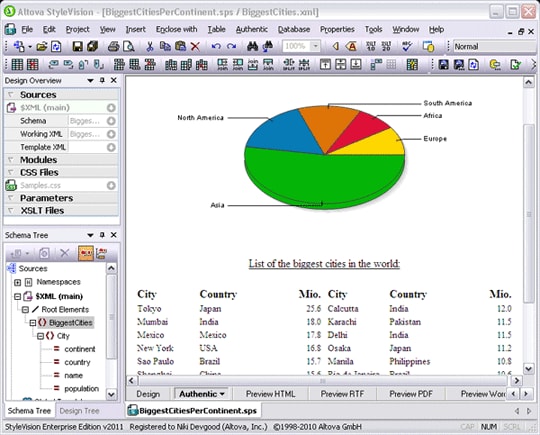 You can even utilize dynamic XPath settings to apply dynamic data from your source to the settings of your chart. For example, if you have a chart that shows regional data, you may wish to reflect the name of each region in the title of your chart. If there are several Region elements, the data for the chart title can be selected dynamically via an XPath expression depending on which set of data is being presented in the chart. Charts are integrated in multi-channel StyleVision reports, described further below. DatabaseSpy Relational database data often lends itself perfectly to a graphical representation, but it’s not always easy to create charts to analyze relationships locked away in database tables. Now, with DatabaseSpy 2011, it’s as simple as selecting the column(s) you wish to chart.
You can even utilize dynamic XPath settings to apply dynamic data from your source to the settings of your chart. For example, if you have a chart that shows regional data, you may wish to reflect the name of each region in the title of your chart. If there are several Region elements, the data for the chart title can be selected dynamically via an XPath expression depending on which set of data is being presented in the chart. Charts are integrated in multi-channel StyleVision reports, described further below. DatabaseSpy Relational database data often lends itself perfectly to a graphical representation, but it’s not always easy to create charts to analyze relationships locked away in database tables. Now, with DatabaseSpy 2011, it’s as simple as selecting the column(s) you wish to chart.  You can even generate and save charts based on calculations performed in a SQL query – such as averages, percentages, etc. As with XMLSpy, charts may be saved as image files, printed, and copied to your clipboard. DatabaseSpy supports all major relational databases, and even with this charting functionality and its other advanced tools, it’s ridiculously affordable.
You can even generate and save charts based on calculations performed in a SQL query – such as averages, percentages, etc. As with XMLSpy, charts may be saved as image files, printed, and copied to your clipboard. DatabaseSpy supports all major relational databases, and even with this charting functionality and its other advanced tools, it’s ridiculously affordable.
REPORTS
StyleVision The new chart creation functionality described above adds a whole new level of sophistication to Altova’s general purpose reporting tool, StyleVision. While you’ve been able to design attractive XML, database, and XBRL reports in previous versions of StyleVision, now you can also include dynamic charts for full featured, multi-channel reporting in digital formats like HTML and e-Forms, and print media including Word and PDF. Advanced options such as drag-and-drop design, absolute positioning, modular designs, conditional templates, support for importing and/or reusing existing XSLT stylesheets, dynamic data selection, and more, combine to make StyleVision robust solution for business reporting on any scale. In fact, StyleVision now integrates with MapForce – so you can design reports for virtually any type of data. MapForce Starting with Version 2011, MapForce supports integration with StyleVision, allowing MapForce users to automatically render results of their XML and XBRL mappings using an associated StyleVision report design. This very powerful feature essentially combines MapForce’s any-to-any data mapping capabilities with a sophisticated rendering engine, meaning that you can now automate chart and report generation from virtually any data format – including databases, flat files, Excel, EDI, and more – that can be mapped to an XML Schema or XBRL taxonomy.
In fact, StyleVision now integrates with MapForce – so you can design reports for virtually any type of data. MapForce Starting with Version 2011, MapForce supports integration with StyleVision, allowing MapForce users to automatically render results of their XML and XBRL mappings using an associated StyleVision report design. This very powerful feature essentially combines MapForce’s any-to-any data mapping capabilities with a sophisticated rendering engine, meaning that you can now automate chart and report generation from virtually any data format – including databases, flat files, Excel, EDI, and more – that can be mapped to an XML Schema or XBRL taxonomy. 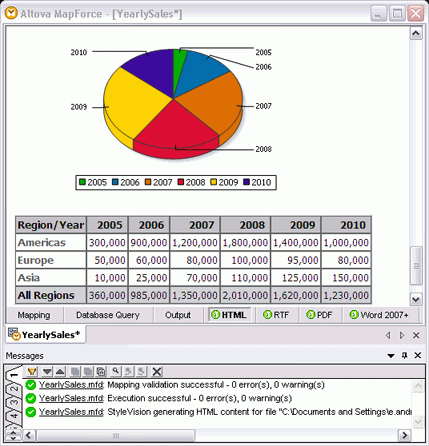
DOWNLOAD VERSION 2011
Whether you need to generate charts while working with XML or databases, or you need to design full-featured reports with dynamic, multi-channel output, we hope you’ll check out the new MissionKit 2011. Then, post a comment here on the blog to let us know what you think! Upgrade or Download a Free Trial See more details and screenshots, or download Version 2011 now. Current customers with active support and maintenance can download the new version for free. A fully functional 30-day trial is also available.
STAY TUNED…
More details about all the new features added in Version 2011 will be posted in the coming days.
August MissionKit Special – Upgrade Now and Save!
Get one year SMP FREE when you upgrade to the Altova MissionKit! For a limited time*, we are offering our current customers the opportunity to get one full year of Support & Maintenance free when they upgrade their individual software product license(s) to the MissionKit tool suite. This represents a potential savings of hundreds or even thousands on Support and Maintenance! The MissionKit brings together innovative tools and standards-based technologies in a comprehensive package that every enterprise architect and application developer needs to complete their software development arsenal.
For a limited time*, we are offering our current customers the opportunity to get one full year of Support & Maintenance free when they upgrade their individual software product license(s) to the MissionKit tool suite. This represents a potential savings of hundreds or even thousands on Support and Maintenance! The MissionKit brings together innovative tools and standards-based technologies in a comprehensive package that every enterprise architect and application developer needs to complete their software development arsenal.
Take advantage of this exciting offer to upgrade to the MissionKit today – it expires on August 31, 2010!*
SMP includes:
Free Software Updates You will receive all maintenance releases and major software versions that are released during your support period – including v2011 as soon as it ships this autumn. Updates that you receive cover the specific edition of the product that you have purchased and typically include many additional features. Priority Technical Support We are extremely proud of our high quality technical support; here are just a few actual customer comments about our excellent support team. “Thanks again for the quick reply. You guys have the fastest response time and in my opinion among the best customer/technical support I have dealt with.”– Sacha Korell, Cobham, plc. “Thank you for the clear explanation and rapid response. Altova provided an excellent customer service for an excellent product.” – Ray Burrows, Ensign Energy Services, Inc. “Working with Altova Support has been my best support experience in my professional life. I really appreciate the way you have understood my obstacles and used your time to remove them. Thank you!” – Frode Reinertsen, NetCom GSM * This limited offer expires on August 31, 2010 and is available from Altova GmbH and its licensed distributors and resellers. The twelve (12) or twenty-four (24) month Support Period for the MissionKit SMP commences on the date that the upgrade order is received and replaces any existing SMP Support Period then in effect for the upgraded licenses. Pricing will automatically reflect that 12 months of the Support Period are at no cost.
MapForce Web Pages in Japanese
We are happy to announce that all MapForce Web pages on the Altova Web site have been fully translated into Japanese, joining the XMLSpy product pages in being completely localized. MapForce 2010, our any-to-any graphical data mapping, conversion, and integration tool, was recently added to the Altova Version 2010 Japanese product line joining XMLSpy 2010, the industry’s best selling XML editor.
 If you haven’t checked out MapForce yet, download a free, 30-day trial today. The Japanese language version of Altova MapForce 2010 is available in Basic, Professional, and Enterprise Editions and can be purchased from the Altova Online Shop or through your preferred reseller.
If you haven’t checked out MapForce yet, download a free, 30-day trial today. The Japanese language version of Altova MapForce 2010 is available in Basic, Professional, and Enterprise Editions and can be purchased from the Altova Online Shop or through your preferred reseller.
New HL7 Online Training Available
HL7 is an international standard for transmitting clinical and administrative information within healthcare domains such as hospitals, pharmaceutical, medical device, and insurance entities.
Altova has just released a new MapForce course as part of its line of free online training modules. This course focuses on HL7 integration using both the EDI (version 2.x) and XML (version 3.x) formats. Each of the three modules include step-by-step tutorials, evaluation exercises, and a chance to work with real HL7 files and functions.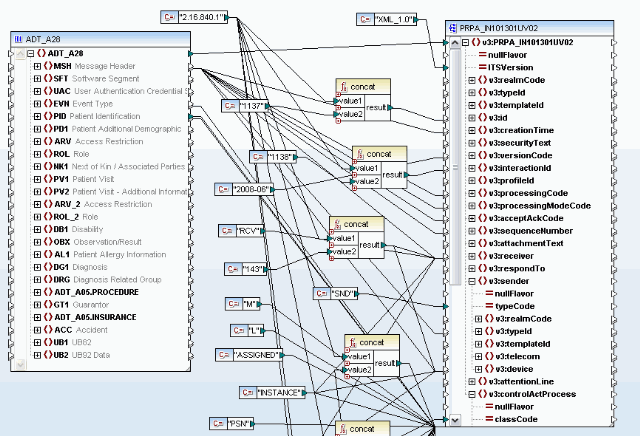 Go on, join the EHR revolution! Download a free 30-day trial of MapForce, go to our training page, and check out powerful HL7 mapping from Altova!
Go on, join the EHR revolution! Download a free 30-day trial of MapForce, go to our training page, and check out powerful HL7 mapping from Altova!
Ride the UML Heat Wave
The same powerful functionality and ease of use that you’ve experienced in other Altova tools is packed into an affordable, intuitive UML modeling tool. UModel supports:
Enter code JULY10 during checkout in the Altova Online Shop for 20% off UModel. Act fast – this sizzling offer expires July 31, 2010. *Savings calculated by comparing published single-user prices of Sparx Enterprise Architect Engineering Edition, Magicdraw Professional Edition, and IBM Rational Software Architect Standard Edition including Rational Modeling Extension for Microsoft .NET, with equivalent UModel Enterprise Edition configured with comparable bundled software maintenance plans.
Using Altova Tools to Work with XML Data in the SQL Azure Cloud
In an earlier post we discussed connecting to Microsoft SQL Azure databases with Altova DatabaseSpy and demonstrated database schema comparison and content comparison between a local database and the same database migrated to SQL Azure. In this post we will use a different method to migrate an existing table to SQL Azure and show you some tricks you can do with XML in the cloud. We started by creating a new database schema in SQL Azure. Then we created a DatabaseSpy project with a connection to a local copy of SQL Server Express running the AdventureWorks sample database, and a second connection to our new SQL Azure schema.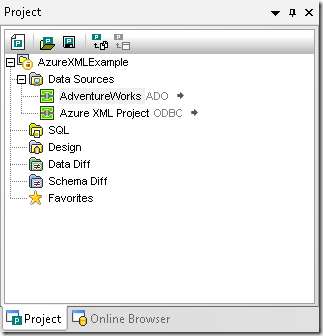 The AdventureWorks database contains a table called JobCandidate with some XML data we will use for a model for our SQL Azure XML contents.
The AdventureWorks database contains a table called JobCandidate with some XML data we will use for a model for our SQL Azure XML contents.  We can generate a CREATE statement for the existing table to use as a basis for the SQL Azure version.
We can generate a CREATE statement for the existing table to use as a basis for the SQL Azure version. 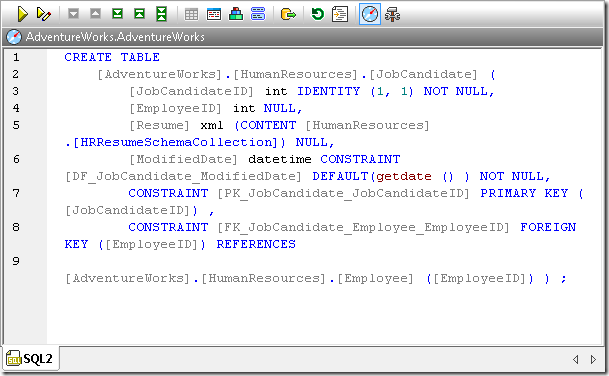 We need to modify this statement to execute in our SQL Azure database. In addition to changing the database and schema names, we will remove the foreign key constraint to the Employee table, since our new database doesn’t contain a table with that name. Also, SQL Azure does not support the CONTENT keyword, so we will remove that as well.
We need to modify this statement to execute in our SQL Azure database. In addition to changing the database and schema names, we will remove the foreign key constraint to the Employee table, since our new database doesn’t contain a table with that name. Also, SQL Azure does not support the CONTENT keyword, so we will remove that as well. 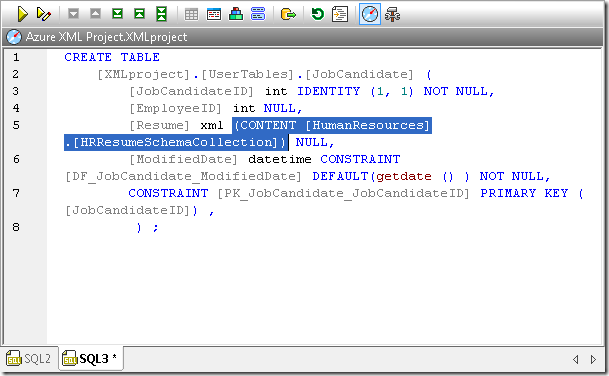 After making sure the Properties window for the revised CREATE statement points to the SQL Azure database, we can execute the statement. When we refresh the database and expand our view in the Online Browser helper window, we can see the new empty table.
After making sure the Properties window for the revised CREATE statement points to the SQL Azure database, we can execute the statement. When we refresh the database and expand our view in the Online Browser helper window, we can see the new empty table. 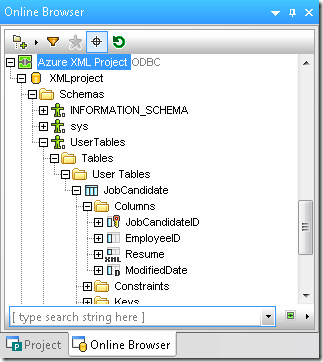 A data comparison between the existing table and the new one will allow us to create a script to migrate data into our new table in the SQL Azure cloud. This is similar to the data comparison we wrote about in our previous post on SQL Azure, except instead of merging data directly, we will save the merge script.
A data comparison between the existing table and the new one will allow us to create a script to migrate data into our new table in the SQL Azure cloud. This is similar to the data comparison we wrote about in our previous post on SQL Azure, except instead of merging data directly, we will save the merge script. 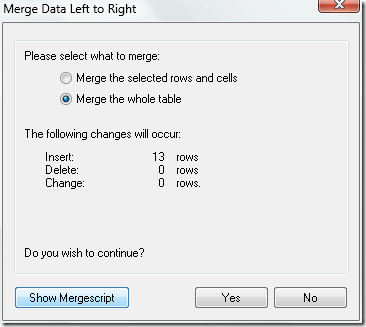 Our first attempt to run the merger script failed, throwing an error message that SQL Azure cannot insert values into the new table when IDENTITY_INSERT is set to OFF. We can add a line to the merge script to SET INDENTITY_INSERT ON and re-execute:
Our first attempt to run the merger script failed, throwing an error message that SQL Azure cannot insert values into the new table when IDENTITY_INSERT is set to OFF. We can add a line to the merge script to SET INDENTITY_INSERT ON and re-execute: 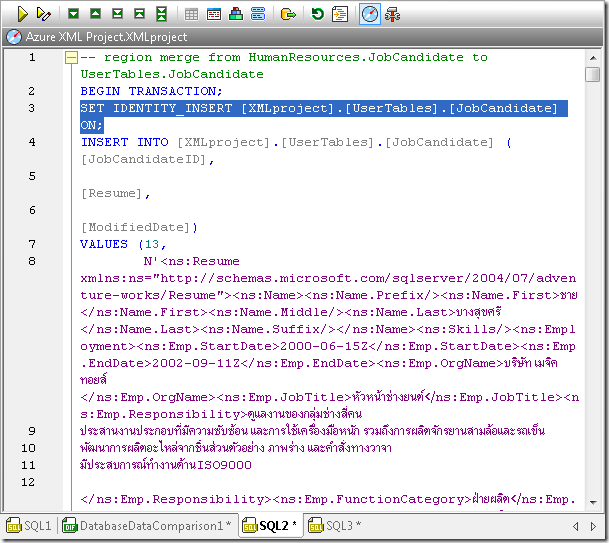 Next, we can run a SELECT query to view the data that was successfully uploaded.
Next, we can run a SELECT query to view the data that was successfully uploaded. 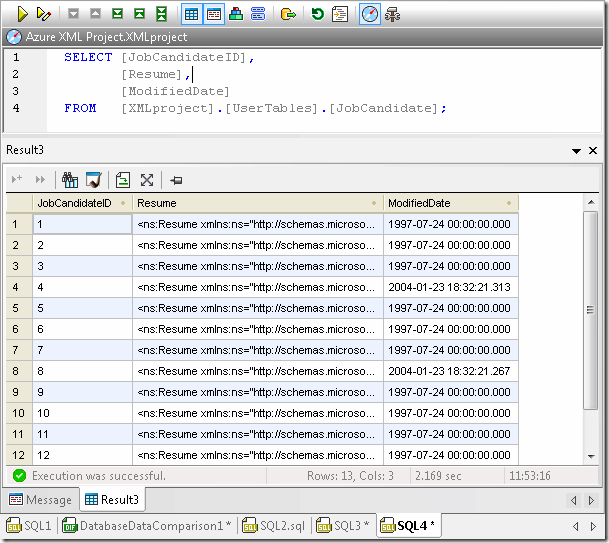 The DatabaseSpy Data Inspector window lets us more easily examine the contents of a wide column, and is ideal to use for XML documents stored in the Resume column of the new JobCandidate table.
The DatabaseSpy Data Inspector window lets us more easily examine the contents of a wide column, and is ideal to use for XML documents stored in the Resume column of the new JobCandidate table. 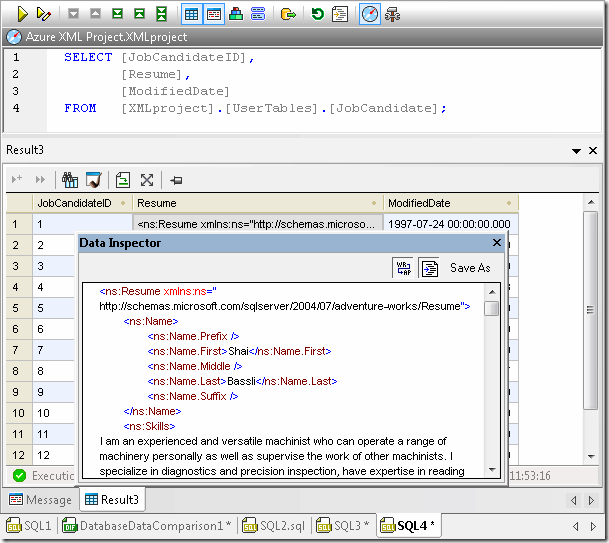 Editing XML Data with XMLSpy If you need to revise, edit, update, or validate XML data in a SQL Azure database, Altova XMLSpy provides more robust XML editing features than DatabaseSpy. We can connect to our SQL Azure database from XMLSpy and run a SELECT query from the XMLSpy Database Query window. XMLSpy lets us open any XML row for direct editing, with access to advanced XML editing functionality.
Editing XML Data with XMLSpy If you need to revise, edit, update, or validate XML data in a SQL Azure database, Altova XMLSpy provides more robust XML editing features than DatabaseSpy. We can connect to our SQL Azure database from XMLSpy and run a SELECT query from the XMLSpy Database Query window. XMLSpy lets us open any XML row for direct editing, with access to advanced XML editing functionality. 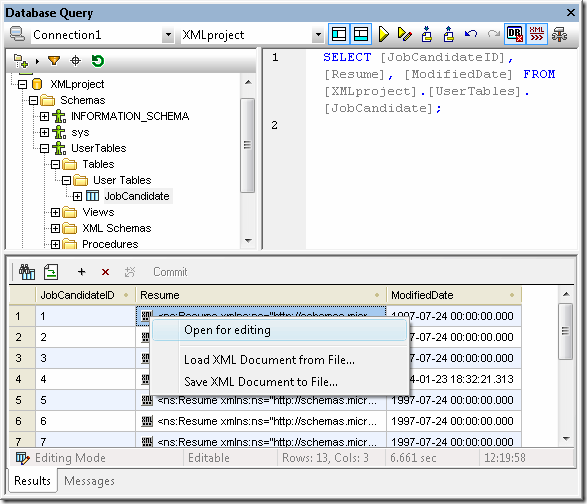 Of course all the familiar features of the XMLSpy text view and grid view are available.
Of course all the familiar features of the XMLSpy text view and grid view are available. 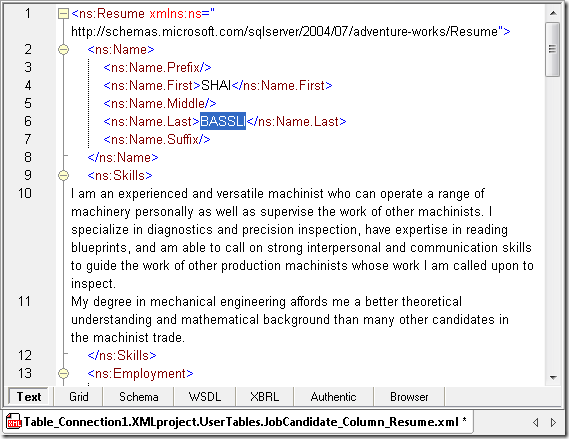
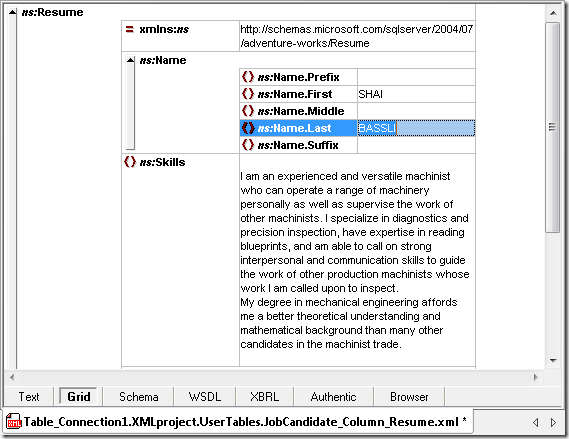 After your edits are complete, the XMLSpy File / Save menu option saves the revised XML document to the same row of the JobCandidate table in the SQL Azure database in the cloud.
After your edits are complete, the XMLSpy File / Save menu option saves the revised XML document to the same row of the JobCandidate table in the SQL Azure database in the cloud. 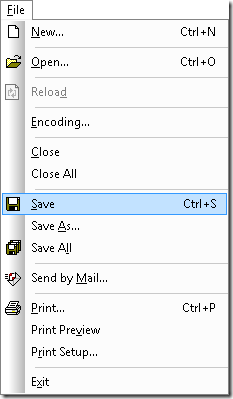 Parsing XML Data with XQuery You can also apply the XMLSpy XQuery editor, with its built-in knowledge of XQuery syntax and context-sensitive entry helpers to build XQuery statements that parse the XML data in your SQL Azure database. The XQuery statement below extracts and returns the home addresses from the XML resumes where JobCandidateID is less than 7.
Parsing XML Data with XQuery You can also apply the XMLSpy XQuery editor, with its built-in knowledge of XQuery syntax and context-sensitive entry helpers to build XQuery statements that parse the XML data in your SQL Azure database. The XQuery statement below extracts and returns the home addresses from the XML resumes where JobCandidateID is less than 7. 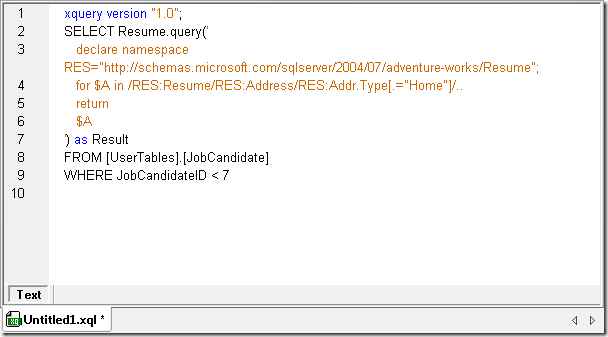 The XQuery statement can be executed in the Database Query window, with results immediately available to work with in XMLSpy.
The XQuery statement can be executed in the Database Query window, with results immediately available to work with in XMLSpy. 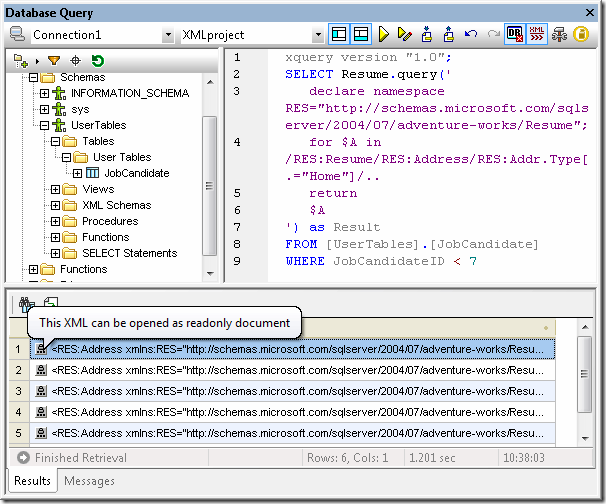 Of course the XQuery result can also be edited in Text view or in Grid view.
Of course the XQuery result can also be edited in Text view or in Grid view. 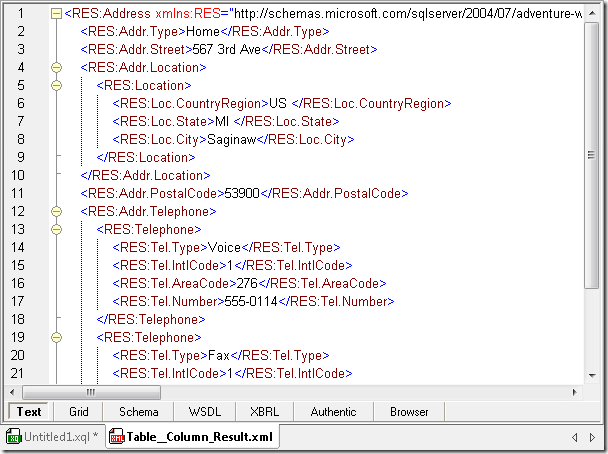
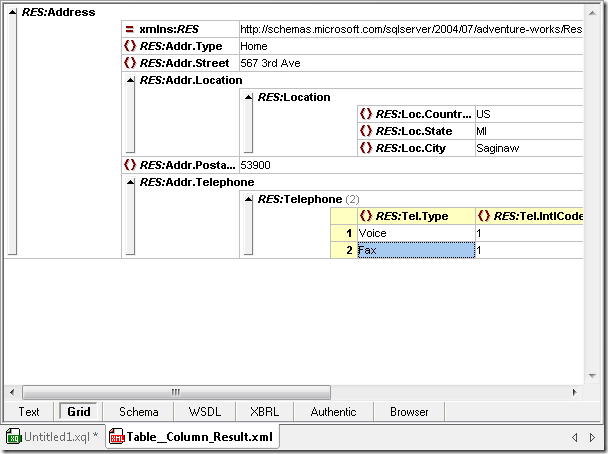 And you can save the query result either from the Database Query window or from the XML Editor view. Find out for yourself how productive you can be by using Altova tools to work with XML data in the SQL Azure cloud ̶ download a free 30-day trial of the Altova MissionKit for Software Architects, an integrated suite that includes XMLSpy, DatabaseSpy, and additional XML, database, and UML tools.
And you can save the query result either from the Database Query window or from the XML Editor view. Find out for yourself how productive you can be by using Altova tools to work with XML data in the SQL Azure cloud ̶ download a free 30-day trial of the Altova MissionKit for Software Architects, an integrated suite that includes XMLSpy, DatabaseSpy, and additional XML, database, and UML tools.
Connecting DatabaseSpy to a SQL Azure Database in the Cloud
Tips and techniques to ease introduction of Microsoft’s cloud-based SQL Azure database into production environments led the topics in June at the Tech-Ed conference in New Orleans. SQL Azure is built on Microsoft SQL Server technologies and is designed to provide a highly-available and scalable database service hosted by Microsoft in the cloud. Developers who deploy databases in SQL Azure do not have to install, setup, patch, or manage any relational database software, only their own database structure and content. Automatic redundancy and fault tolerance are built-in and no physical administration is required. You can build a manual connection string and use SQL Server syntax and datatypes to connect DatabaseSpy and other Altova tools to SQL Azure databases to perform typical database development and maintenance tasks. This blog post makes a connection to a SQL Azure database from DatabaseSpy and demonstrates several typical operations you might want to perform as you migrate an existing database to the cloud. To retrace these steps on your own you will need a SQL Azure account, or a login and password created by a SQL Azure account holder. For more information on setting up a SQL Azure account, visit the Microsoft SQL Azure home page. You will also need to install the SQL Server Native Client 10.0 (or later). SQL Azure does not behave exactly like a local SQL Server database, so we can’t use the Altova SQL Server connection wizard. Instead we will use an ODBC connection.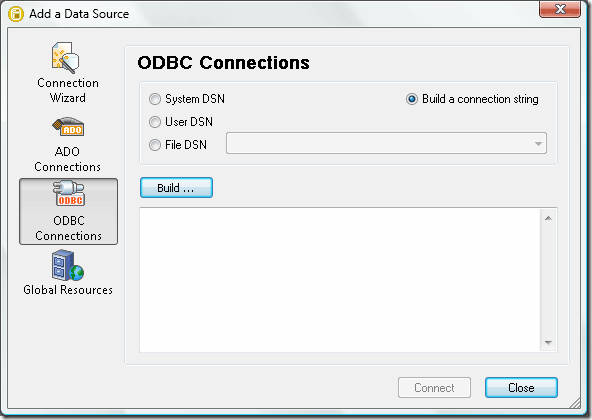 We won’t illustrate all the details of the process of building a new connection string here. You can paste an existing connection string into the dialog shown above, or, if you need specific instructions for each step to manually create a new string, you can refer to the Tech Note titled Build an ODBC Connection String for SQL Azure on the Altova Web site. After you connect to SQL Azure the first time, a DatabaseSpy project file lets you save all your connection settings along with frequently-used SQL scripts, database design files, and database comparisons in a convenient bundle to reload later. The screenshot below shows a new DatabaseSpy project with two databases connected simultaneously, Sakila in MySQL and Sakila in the cloud in SQL Azure.
We won’t illustrate all the details of the process of building a new connection string here. You can paste an existing connection string into the dialog shown above, or, if you need specific instructions for each step to manually create a new string, you can refer to the Tech Note titled Build an ODBC Connection String for SQL Azure on the Altova Web site. After you connect to SQL Azure the first time, a DatabaseSpy project file lets you save all your connection settings along with frequently-used SQL scripts, database design files, and database comparisons in a convenient bundle to reload later. The screenshot below shows a new DatabaseSpy project with two databases connected simultaneously, Sakila in MySQL and Sakila in the cloud in SQL Azure. 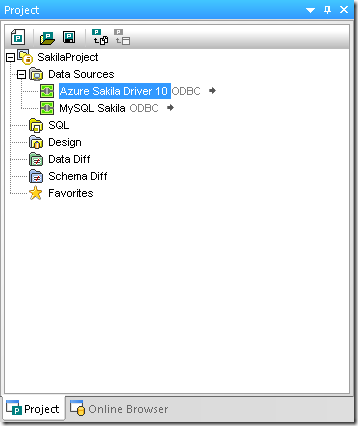 Microsoft provides a number of conversion tools to help users migrate existing databases to the SQL Azure platform. We used the Microsoft SQL Server Migration Assistant for MySQL to convert our local MySQL Sakila sample database to our SQL Azure account. DatabasesSpy lets users open multiple connections simultaneously, even to databases of different types. The database comparison functionality of DatabaseSpy makes it an ideal tool to check the results of the Sakila conversion. First we will open a database schema comparison and select a few tables from the MySQL database for the left side of the comparison.
Microsoft provides a number of conversion tools to help users migrate existing databases to the SQL Azure platform. We used the Microsoft SQL Server Migration Assistant for MySQL to convert our local MySQL Sakila sample database to our SQL Azure account. DatabasesSpy lets users open multiple connections simultaneously, even to databases of different types. The database comparison functionality of DatabaseSpy makes it an ideal tool to check the results of the Sakila conversion. First we will open a database schema comparison and select a few tables from the MySQL database for the left side of the comparison.  After we select the corresponding tables from SQL Azure version, the tables open in a database schema comparison window.
After we select the corresponding tables from SQL Azure version, the tables open in a database schema comparison window. 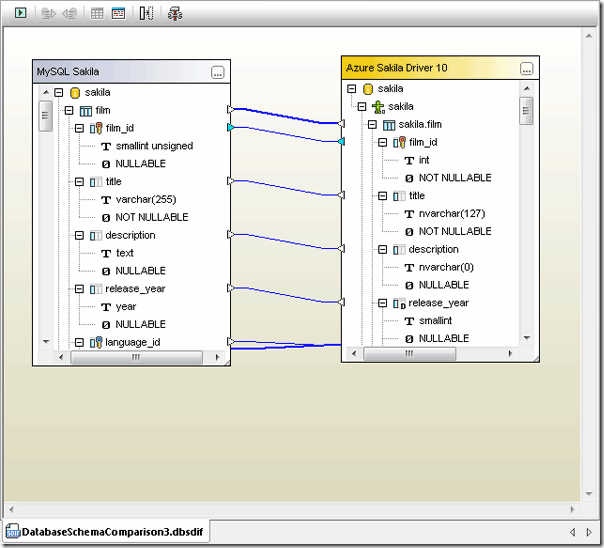 When we click the green compare button at the top left corner of the window, DatabaseSpy compares the database structures, highlights differences, and generates a summary in the message window.
When we click the green compare button at the top left corner of the window, DatabaseSpy compares the database structures, highlights differences, and generates a summary in the message window. 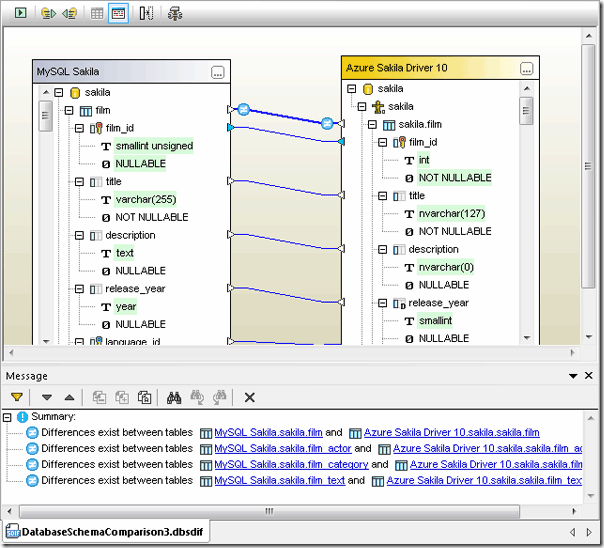 Some differences represent datatype definitions that vary between databases. For instance, the MySQL type unsigned small int does not have an exact equivalent in SQL Server, so the conversion tool substituted the int type for the film_id column in the film table. Also, the year datatype assigned to the release_year column in MySQL has been converted to a smallint in SQL Azure. I guess this will make the SQL Azure version of the database more forward-compatible, since it will be able to accommodate films released all the way through the year 32,767, as opposed to 2155, which is the maximum value of the year datatype in MySQL! We can compare data contained in the two databases via a selection in the right-click context menu, opening the selected tables in a new data comparison window.
Some differences represent datatype definitions that vary between databases. For instance, the MySQL type unsigned small int does not have an exact equivalent in SQL Server, so the conversion tool substituted the int type for the film_id column in the film table. Also, the year datatype assigned to the release_year column in MySQL has been converted to a smallint in SQL Azure. I guess this will make the SQL Azure version of the database more forward-compatible, since it will be able to accommodate films released all the way through the year 32,767, as opposed to 2155, which is the maximum value of the year datatype in MySQL! We can compare data contained in the two databases via a selection in the right-click context menu, opening the selected tables in a new data comparison window. 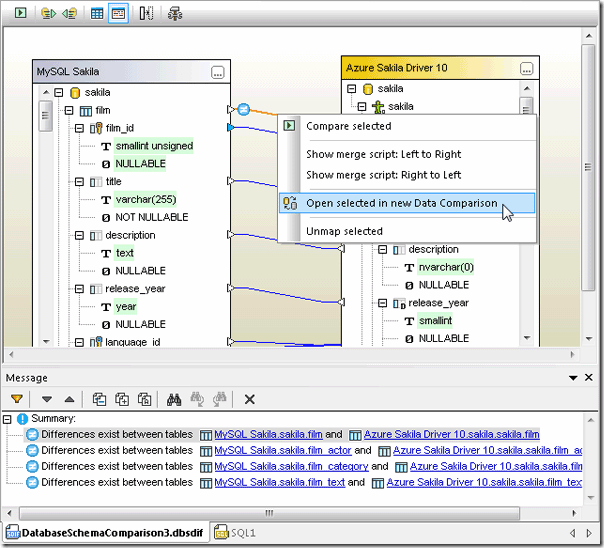 The data comparison shows us the contents of the tables are not identical.
The data comparison shows us the contents of the tables are not identical. 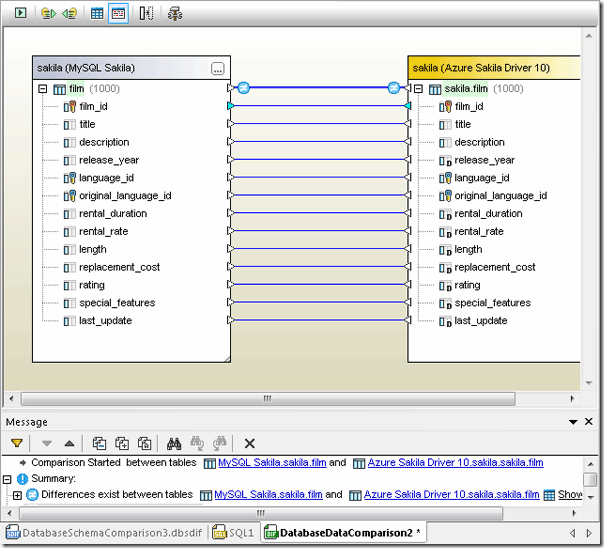 When we open the results window, we see that the description column did not migrate successfully.
When we open the results window, we see that the description column did not migrate successfully. 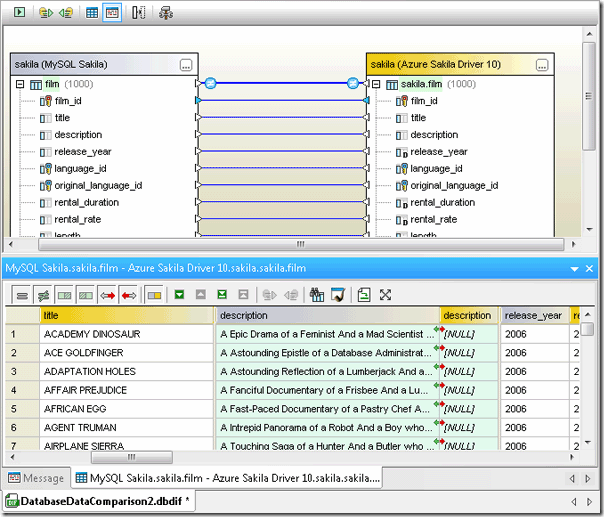 Looking back at the Database Schema Comparison window, we can see the length of the description column was set to zero. This explains the red arrows that point from the description column in MySQL to the description column in SQL Azure in the Results window. We cannot copy any string of text into a column with a defined length of zero. Instead, let’s open the SQL Azure version of the film table in a new Design window.
Looking back at the Database Schema Comparison window, we can see the length of the description column was set to zero. This explains the red arrows that point from the description column in MySQL to the description column in SQL Azure in the Results window. We cannot copy any string of text into a column with a defined length of zero. Instead, let’s open the SQL Azure version of the film table in a new Design window. 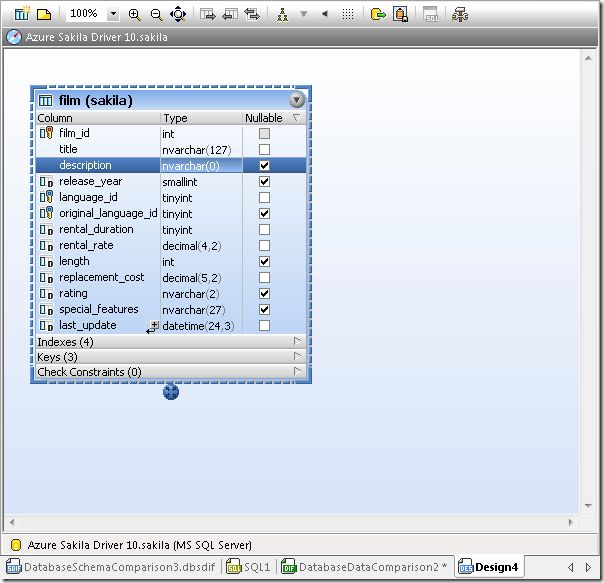 We can increase the size of the description field in the Properties window, and run the resulting change script.
We can increase the size of the description field in the Properties window, and run the resulting change script. 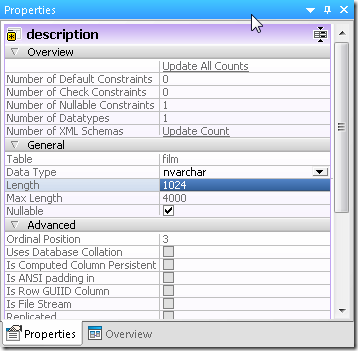
 Next, when we re-run the data comparison, we find that the data was converted, but the previously defined field length of zero made the data invisible.
Next, when we re-run the data comparison, we find that the data was converted, but the previously defined field length of zero made the data invisible. 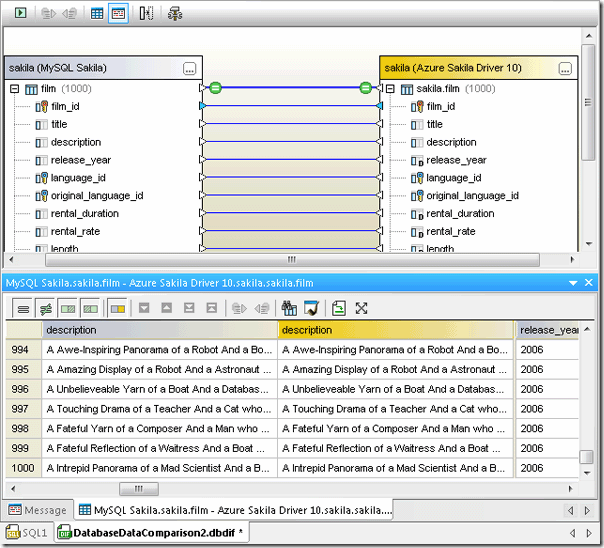 Latency Issues You can use DatabaseSpy to explore latency issues for the cloud database vs. the local copy. We saw from the data comparison above that the film tables in the two databases contain 1,000 rows of identical data. We can repeatedly run SELECT statements to retrieve the data from SQL Azure and from the local MySQL database to time the results. The DatabaseSpy SQL Editor message window displays the execution time.
Latency Issues You can use DatabaseSpy to explore latency issues for the cloud database vs. the local copy. We saw from the data comparison above that the film tables in the two databases contain 1,000 rows of identical data. We can repeatedly run SELECT statements to retrieve the data from SQL Azure and from the local MySQL database to time the results. The DatabaseSpy SQL Editor message window displays the execution time.  Running the above SELECT statement five consecutive times on the SQL Azure version of the sakila database generated results ranging from 60.632 seconds to 63.851 seconds. Running a SELECT statement for the same film table in the local MySQL database yielded the following result:
Running the above SELECT statement five consecutive times on the SQL Azure version of the sakila database generated results ranging from 60.632 seconds to 63.851 seconds. Running a SELECT statement for the same film table in the local MySQL database yielded the following result: 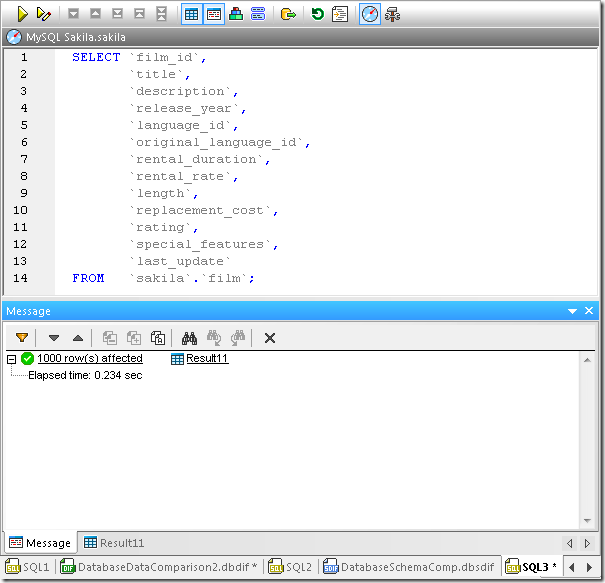 Repeating the test for the local version generated similar times. The takeaway for developers is your database-driven application will likely need to accommodate latency as you move your data to the cloud. Try your own connection to SQL Azure with a free trial of Altova DatabaseSpy.
Repeating the test for the local version generated similar times. The takeaway for developers is your database-driven application will likely need to accommodate latency as you move your data to the cloud. Try your own connection to SQL Azure with a free trial of Altova DatabaseSpy.
Altova Named to SD Times 100
the award for “Tools & Frameworks” goes to Altova!
MapForce Japanese Version – 日本語版 MapForce
ホームページと XMLSpy 製品ページ含む Altova ウェブページの多くが日本語化されました!この作業は今後も継続して行われ、新たに翻訳されたページもできる限り素早く追加していく予定です。 We are excited to announce that a large portion of the Altova Web site – including the home page and XMLSpy product pages – is now available in Japanese! This is an ongoing effort, and new translated pages are being added as quickly as possible.
日本語版 MapForce 2010
他にも、次の日本語化された Altova バージョン 2010 製品となる MapForce 2010 のリリースを行いました。MapForce データマッピングツールは XMLSpy と共に完全に翻訳され、英語版、ドイツ語版と共にお求め頂けます(単一のライセンスキーコードにより使用する言語に関係なく製品のアンロックを行うことができます)。 日本語ユーザも、XML、データベース、EDI、フラットファイル、Excel 2007+、XBRL、そしてウェブサービスと言ったデータのマッピングと変換をグラフィカルに行う MapForce インターフェースを利用できるようになりました。無料トライアル版をダウンロードする際に、言語ドロップダウンから日本語を選択してください。 続けてその他の製品についても、地域化を続けて行く予定です。ご期待下さい! We’ve also released the next Altova Version 2010 product to be localized in Japanese: MapForce 2010. The MapForce data mapping tool joins XMLSpy in being fully translated and available for download in Japanese as well as English and German. (A single license key code unlocks whichever language version you install.) Now Japanese-speaking users can take advantage of the graphical MapForce interface for mapping and transforming data in any format, including XML, databases, EDI, flat files, Excel 2007+, XBRL, and Web services. Simply select Japanese from the language drop down when downloading a free trial. We will continue localizing the rest of the product line throughout the year – stay tuned for more news!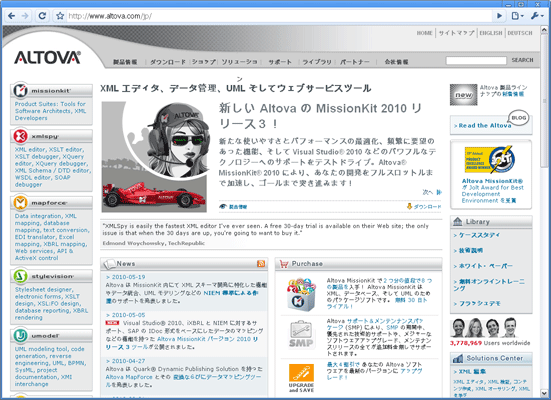
Visit Altova at TechEd
Updated Industry Schema Library
Maybe we can help. Altova’s updated schema library is a collection of over 100 industry and cross-industry XML Schema and DTD specifications – all in one central location. XML standards (and technology standards in general) are used to promote information sharing and interoperability across disparate software and systems. In a perfect world, this would translate to a global network of data being exchanged seamlessly between information partners… in a perfect world. However, there are some industries that are reaping the rewards of standardization, and hopefully these efforts will pave the way for more. Very recently we have seen an increased interest and even some actionable mandates in XBRL for financial data, HL7 for exchanging healthcare messages, and NIEM for inter-agency communication within the United States government. Of course, if you do find yourself working with some conflicting technology standards, you should probably take a look at Altova MapForce. With native support for visually mapping pretty much any data formats you can think of (XML, databases, flat files, EDI, Excel 2007+, XBRL, and Web services), easily adding data processing functions, and a whole bunch of automation options, you may even find that creating data integration solutions is well… kind of fun. Check out Altova’s Industry Schema Library, or download a free 30-day trial of MapForce today!
Working with XML in Databases
More and more users are storing XML documents in database columns, especially when XML data is sent or received from other entities. Storing data in XML helps enterprises more easily accommodate revisions to industry-standard data formats as XML Schemas evolve over time. One challenge in migrating from a relational database to an XML-oriented database application is developing queries that replace traditional SQL queries of relational data to parse XML documents stored in the database. We recently had an opportunity to address XQuery for XML in databases in a presentation titled Altova Tools for DB2® in a teleconference sponsored by IBM® for the pureXML™ Devotees user group. After an introduction and brief background on Altova, we focused on the special functionality included in XMLSpy to manage XML Schemas in DB2 and to edit XML data stored in DB2. The XMLSpy Database Query Window makes it easy to edit XML database content directly in XMLSpy. Altova has built specialized capabilities for deep integration of Altova tools with the DB2 pureXML data server to help customers working with XML, XML Schema, XQuery, and other XML-related technologies. We demonstrated the XMLSpy XQuery editor, XQuery debugger and XQuery profiler, with support for executing XQuery scripts directly against the DB2 database and for the special DB2 xmlcolumn and sqlquery operators. We closed the presentation with a walk-through of the steps a user can take to migrate legacy relational data to an XML-based application, including inferring an XML Schema from relational data in a table in DB2, then importing data from the table and automatically tagging it in XML according to the new XML Schema. We have uploaded a PDF file the slides from the presentation on SlideShare. You can also get a copy at the IBM pureXML Devotees page, where you can listen to the recorded audio as well. The best way to experience for yourself how well the features of XMLSpy, MapForce, StyleVision, and DatabaseSpy work with DB2 and other databases with XML is to click here to download a free trial of the Altova MissionKit.
Altova has built specialized capabilities for deep integration of Altova tools with the DB2 pureXML data server to help customers working with XML, XML Schema, XQuery, and other XML-related technologies. We demonstrated the XMLSpy XQuery editor, XQuery debugger and XQuery profiler, with support for executing XQuery scripts directly against the DB2 database and for the special DB2 xmlcolumn and sqlquery operators. We closed the presentation with a walk-through of the steps a user can take to migrate legacy relational data to an XML-based application, including inferring an XML Schema from relational data in a table in DB2, then importing data from the table and automatically tagging it in XML according to the new XML Schema. We have uploaded a PDF file the slides from the presentation on SlideShare. You can also get a copy at the IBM pureXML Devotees page, where you can listen to the recorded audio as well. The best way to experience for yourself how well the features of XMLSpy, MapForce, StyleVision, and DatabaseSpy work with DB2 and other databases with XML is to click here to download a free trial of the Altova MissionKit.
Altova Adds to NIEM Support in v2010r3
Clashes between government agencies are the stuff of legends and entire TV shows: the FBI and the CIA, the local sheriff’s department and the big city CSI, Homeland Security and the Pentagon, Jack Bauer and CTU. Perhaps this has to do with the territorial nature of some of these entities, but perhaps, just perhaps, technology has a part to play in these conflicts. Incompatible architectures and data formats, legacy systems, and other technology road blocks within the United States government sometimes made it difficult for agencies to efficiently share pertinent information such as arrest reports, amber alerts, immigration details, and more.
The National Information Exchange Model (NIEM) is an XML-based standard for data exchange between United States government agencies and their information partners. It aims to provide a means for these entities to improve decision making, achieve greater operating efficiency, mitigate risk, improve public safety, and increase ROI through intergovernmental information exchange.
As a leader in XML tools and technologies, the Altova MissionKit already inherently supports NIEM on a variety of different levels. In v2010r3, we added two very specific features to XMLSpy that extend the XML editor with capabilities that are invaluable for NIEM development. For more on these features, see the recent NIEM blog post by our CEO and XML Aficionado, Alexander Falk.
Below is a brief overview of the support provided for NIEM across the MissionKit, from XML Schema editing in XMLSpy, to XMI import and UML diagramming in UModel, to data integration in MapForce, and beyond.
XMLSpy
XMLSpy® 2010 provides a graphical schema design interface which simplifies the development of XML Schemas, allowing XML code to be generated in real-time behind the scenes. Users can switch back and forth between this view and text view at any time during their design process.
The graphical schema editor provides built-in support for creating the IEPD Extension Schema, Constraint Schema, and Exchange Schema.
In addition to the broad XML Schema support described above, XMLSpy provides comprehensive support for all other prevalent XML technologies, including:
UML Diagrams
The first stage in any development lifecycle is a thorough business requirements review. UML is particularly well-suited to modeling software projects because it provides a standardized approach to the design process. Scenario-based planning is recommended for NIEM, and though there is no UML diagram requirement, class diagrams, use-case diagrams, and sequence diagrams all provide value to IEPD documentation. In addition, NIEM provides a free tool for mapping data requirements based on an uploaded XMI representation of a UML model
UModel® 2010 is an advanced UML tool that supports all fourteen UML 2.3 diagrams, BPMN, SysML, and more. It works seamlessly with XML technologies like XMI, letting users easily import and export XMI based on their UML diagrams. UModel can even render XML Schemas in a format similar to UML diagrams and integrates seamlessly with all other MissionKit tools including XMLSpy, MapForce, and SchemaAgent. UModel also supports code generation, round-trip engineering, and reverse engineering, as well as integration with the popular Visual Studio and Eclipse IDEs.
UModel can be used two different phases of NIEM development:
XML Schema Management
Because of the potential to have many different schemas in each IEPD, XML Schema management can become an arduous process. SchemaAgent® 2010 is a unique file management tool that lets users visually manage their XML Schema, XML, XSLT, and WSDL assets in a project-based environment so that changes and structure of the file configuration can be easily recognized. SchemaAgent users can even view mapping files created using MapForce.
Data Mapping & Exchange
Data mapping is a crucial step at several levels in the NIEM process. Mapping helps users generate a subset schema to determine what elements can be used from the core and domain models, it is also used to perform a transform from one NIEM vocabulary to another. Some NIEM implementations also employ Web services to provide a mechanism for the exchange.
MapForce® 2010 is an any-to-any data mapping and integration tool that supports all of the potential data formats used in the NIEM lifecycle including XML, databases, flat files, Excel 2007+, and Web services. MapForce maps data based on its underlying structure (i.e. XML Schema), enabling mapping designs to be reused for recurrent transformations. MapForce also supports mapping to and from multiple source or target components. In addition, MapForce can be used to generate documentation detailing mapping projects for non-technical stakeholders in a variety of formats such as HTML and Microsoft® Word.
To try out this functionality on your own, download a free 30-day trial of Altova MissionKit now!
Start your Engines with Release 3 of the Altova MissionKit 2010!
Integration with Visual Studio 2010
Multiple Altova tools have long supported seamless integration with Visual Studio, allowing you to use their complete feature set inside the VS environment to access advanced or specialized functionality not available within Visual Studio. These include :
With Release 3, this functionality has been updated to support Visual Studio 2010, which was released by Microsoft® last month. This adds to previous support for Visual Studio 2005 and 2008.
XMLSpy 2010 Release 3
New functionality includes:
An oft-requested feature, extended schema validation allows you to validate naming and coding conventions outside the scope of the XML Schema standard. This gives you more control over your XML architecture by allowing you to further constrain the way that elements and attributes are created and defined. An example application of this powerful feature is within the National Information Exchange Model (NIEM), though it can be used for any set of rules defined by your organization or project. Another feature implemented based on XMLSpy customer requests is user-defined sample values for XML instance generation. While previous versions of the XML editor supported generation of XML instances using data supplied by XMLSpy, with v2010r3 you can now specify your own sample data so that the generated files will contain arbitrary results selected from pre-supplied values. These new features are very important for users working with NIEM and other standards – and you’ll only find them in XMLSpy. If you happen to be working with NIEM, be sure to read how the Altova MissionKit provides end-to-end support for NIEM, from IEPD development and planning, to the implementation of an exchange.
Another feature implemented based on XMLSpy customer requests is user-defined sample values for XML instance generation. While previous versions of the XML editor supported generation of XML instances using data supplied by XMLSpy, with v2010r3 you can now specify your own sample data so that the generated files will contain arbitrary results selected from pre-supplied values. These new features are very important for users working with NIEM and other standards – and you’ll only find them in XMLSpy. If you happen to be working with NIEM, be sure to read how the Altova MissionKit provides end-to-end support for NIEM, from IEPD development and planning, to the implementation of an exchange.
More R3 Highlights
Here are just a few other highlights from this most recent release across the Altova product line:
MapForce 2010r3
StyleVision 2010r3
UModel 2010r3
DatabaseSpy 2010r3
DiffDog 2010r3
Altova MapForce Brings Powerful Data Transformation Capabilities to Quark Dynamic Publishing Solution
This week Altova announced the integration of Altova MapForce, its conversion and data mapping tool, with Quark® Dynamic Publishing Solution. Through Automation Services™, a component of Quark’s dynamic publishing software, MapForce transformations translate XML into Web publishing formats, transform QuarkXPress® layouts for digital publishing, and convert XML to print pages, providing multi-channel publishers with a complete, automated XML-based publishing solution. This solution highlights two powerful features of MapForce that have demonstrated benefits to users with a wide range of data conversion needs: The MapForce visual data mapping interface supports integrating data as the source or destination in virtually any format, including XML, databases, flat files, EDI, Excel 2007+, XBRL, and Web services. MapForce includes the ability to automate data integration and repeatable business processes through an automation interface that lets developers access its advanced features programmatically. Users can also automate MapForce through the command line interface, or by using MapForce generated royalty-free code in XSLT 1.0/2.0, XQuery, Java, C++ or C#. “Having the ability to transform and publish data to multiple channels using an automated process helps users improve productivity and cut costs,” said Alexander Falk, President and CEO for Altova. The Altova Web site features a series of MapForce flash videos that each demonstrate a significant feature in 4 minutes or less. The Altova Online Training page offers three free MapForce self-paced training modules for Beginning, Intermediate, and Advanced data integration needs. Find out for yourself how convenient and cost-effective can be to solve your data conversion requirements. Click here to download a fully functional, free 30-day trial of Altova MapForce 2010!
“Having the ability to transform and publish data to multiple channels using an automated process helps users improve productivity and cut costs,” said Alexander Falk, President and CEO for Altova. The Altova Web site features a series of MapForce flash videos that each demonstrate a significant feature in 4 minutes or less. The Altova Online Training page offers three free MapForce self-paced training modules for Beginning, Intermediate, and Advanced data integration needs. Find out for yourself how convenient and cost-effective can be to solve your data conversion requirements. Click here to download a fully functional, free 30-day trial of Altova MapForce 2010!
Altova MissionKit Integration with Visual Studio – On with the Show!
Splitting Large UML Sequence Diagrams
A new feature introduced in UModel 2010 release 2 allows you to split large sequence diagrams when you reverse engineer existing Java, C#, or Visual Basic source code. What are the advantages of splitting a sequence diagram, and how should you decide to split or not? Obviously, a single diagram makes it easy to examine in one view all the interactions that occur during the execution of a class operation. On the other hand, a large, complex diagram can be cumbersome to view, navigate, analyze, and print in a readable format. Fortunately, UModel 2010r2 makes it quick and easy to experiment. After you generate your sequence diagram, if you don’t like the results, just click the Undo button and you can create a new variation by choosing different options in the Sequence Diagram Generation dialog. Or, you can even apply the Generate Sequence Diagram feature more than once to the same class operation, and maintain multiple versions of the sequence diagram in your model. For instance, if you plan to modify the existing code, you might want to keep a permanent record of the “before” and “after” editions to document your changes. We recently adapted our analysis of a bank ATM legacy application to create two new Technical Briefs in the Reference Library section of the Altova Web site, titled Analyze a Legacy Application with Altova UModel and Enhance a Legacy Application with Altova UModel. Enhancement of the code included adding a new method called getFinalOkay directly in the original source code file for the Withdrawal class. When we completed the round trip by synchronizing our UModel project with the application code, the split version of the sequence diagram included a dedicated sub-diagram for the new method. The sub-diagram is automatically labeled with a note and hyperlinked to the main diagram. If you’re ready to see for yourself how a visual software model can help you work with your own legacy application, click here to download a fully-functional free trial of Altova UModel!
If you’re ready to see for yourself how a visual software model can help you work with your own legacy application, click here to download a fully-functional free trial of Altova UModel!
XML: The Power Behind XBRL
Just yesterday my new article, “Robust XML Technologies Provide an Ideal Foundation for XBRL”, was posted on the Data Interactive blog – an excellent place to get XBRL insights from financial data and technology experts. My hope here was to underline the fact that, even though it adds a very powerful semantic layer, XBRL is still based on XML. XML lends not only the convenience of extensibility, but opens the door to a whole family of technologies including XSLT, XQuery, XPath, and more. Many of our readers are familiar with all of the power and flexibility that these languages provide – and, in fact, the widespread popularity of XML technologies means that someone in your organization probably is too. Check out the full article at http://hitachidatainteractive.com/ and let your XML developers take your data out for a test drive.
New MapForce Online Training
If you’re not already familiar with MapForce, Altova’s award-winning graphical data integration tool, now’s the perfect time! Altova has just released a new MapForce course as part of its line of free online training modules. The new course has been completely updated with comprehensive data mapping training for beginning, intermediate, and advanced users and includes step-by-step tutorials, evaluation exercises, and a chance to work with mapping files and functions that meet a broad range of needs.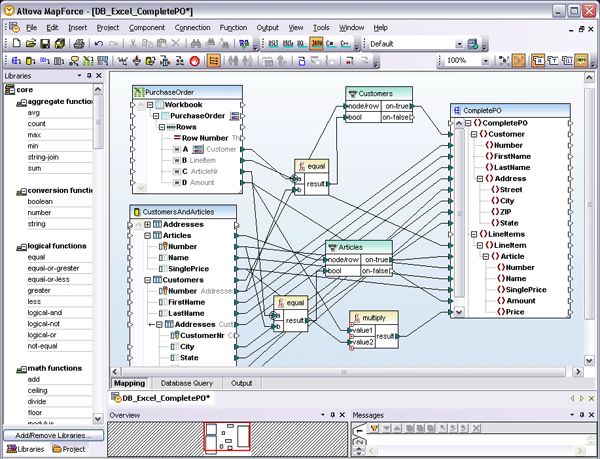 So roll up your sleeves, download a free 30-day trial of MapForce, go to our training page, and get your hands dirty with some powerful visual data transformation from Altova!
So roll up your sleeves, download a free 30-day trial of MapForce, go to our training page, and get your hands dirty with some powerful visual data transformation from Altova!
XMLSpy 2010 日本語版のご案内
XMLSpy 2010 は、バージョン 2010 の Altova 製品としては初めての日本語版製品となります。新たに日本語化された XMLSpy XML エディターは部分的に翻訳されていた既存のバージョンを置き換え、ユーザは英語ならびにドイツ語版で既に利用可能な XML に関する全ての編集、変換、そしてデバッグといったパワフルな機能を利用することができます。 XMLSpy 2010 は完全に翻訳された初めての日本語版製品となりますが、他の製品の日本語版も数か月中にリリースを予定しており、その後日本語のリファレンスマニュアルならびにウェブサイトが続くことになります。地域化サービスを社内で行うことで、日本市場に対する我々のコミットメントを示し、削減した経費を顧客に還元します。 XMLSpy 2010r2 を既にお使いのお客様は、既存のキーコードを入力することにより全ての言語のバージョンでロックの解除を行うことができます。または、30日間の無料トライアル版の XMLSpy 2010 をダウンロードすることで、バージョン 2010r2 で利用可能な全てのパワフルな機能を使用することができます。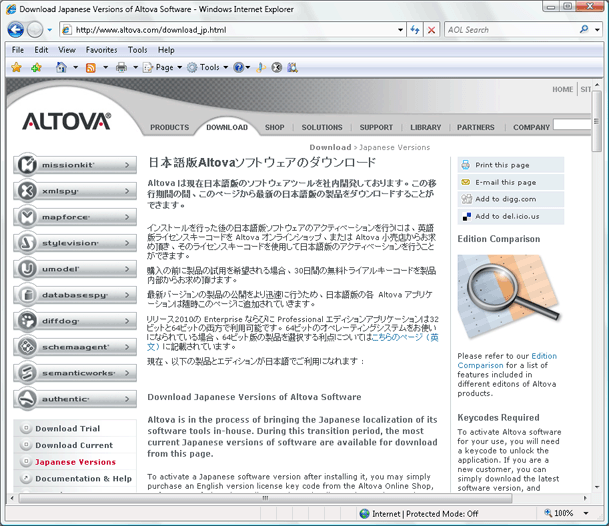 XMLSpy バージョン 2010r2 はネイティブ64ビットへの対応を含め、多数のスピードならびにパフォーマンスの向上が図られています。100MB以上の XML ファイルを使った作業を行う場合、64ビットのオペレーティングシステムに最適化されたスピードとパフォーマンスの恩恵にあずかることができます。新しい64ビットバージョンの XMLSpy 2010 にて非常に巨大なファイルを使った作業を行う際には、マシンに搭載されているメモリの容量が唯一の制限になります。 日本語版の Altova XMLSpy 2010r2 には現在スタンダード、プロフェッショナル、そしてエンタープライズエディションが用意され、価格は149ユーロ (約18,200円) からになり、現在 Altova Online Shop または小売店を通してお求め頂けます。 Introducing XMLSpy 2010 Japanese Language Edition XMLSpy 2010 is the first product in Altova’s all-new Version 2010 Japanese product line. The new fully localized Japanese edition of the XMLSpy XML editor replaces the previous partially translated version and allows you to take advantage of the same powerful functionality available in XMLSpy’s English and German counterparts for editing, transforming, and debugging XML-related technologies. XMLSpy 2010 is the first product to be completely translated but we have plans to release Japanese language versions of our other products in the coming months, followed by Japanese reference manuals and a Japanese Web site. Our decision to bring the localizations services in-house demonstrates our commitment to the Japanese market, and allows us to pass that cost savings on to you, our customers. Current XMLSpy v2010r2 customers can now unlock any language version using your existing key code, or download a free trial of XMLSpy 2010 to begin using all of the powerful new functionality available in Version 2010r2.
XMLSpy バージョン 2010r2 はネイティブ64ビットへの対応を含め、多数のスピードならびにパフォーマンスの向上が図られています。100MB以上の XML ファイルを使った作業を行う場合、64ビットのオペレーティングシステムに最適化されたスピードとパフォーマンスの恩恵にあずかることができます。新しい64ビットバージョンの XMLSpy 2010 にて非常に巨大なファイルを使った作業を行う際には、マシンに搭載されているメモリの容量が唯一の制限になります。 日本語版の Altova XMLSpy 2010r2 には現在スタンダード、プロフェッショナル、そしてエンタープライズエディションが用意され、価格は149ユーロ (約18,200円) からになり、現在 Altova Online Shop または小売店を通してお求め頂けます。 Introducing XMLSpy 2010 Japanese Language Edition XMLSpy 2010 is the first product in Altova’s all-new Version 2010 Japanese product line. The new fully localized Japanese edition of the XMLSpy XML editor replaces the previous partially translated version and allows you to take advantage of the same powerful functionality available in XMLSpy’s English and German counterparts for editing, transforming, and debugging XML-related technologies. XMLSpy 2010 is the first product to be completely translated but we have plans to release Japanese language versions of our other products in the coming months, followed by Japanese reference manuals and a Japanese Web site. Our decision to bring the localizations services in-house demonstrates our commitment to the Japanese market, and allows us to pass that cost savings on to you, our customers. Current XMLSpy v2010r2 customers can now unlock any language version using your existing key code, or download a free trial of XMLSpy 2010 to begin using all of the powerful new functionality available in Version 2010r2. 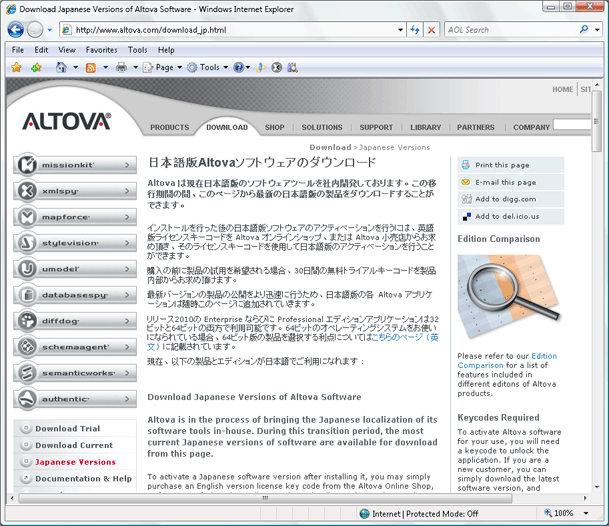 XMLSpy Version 2010r2 delivers several new speed and performance enhancements, including a native 64-bit version that allows you to take advantage of the speed and performance optimizations associated with 64-bit operating systems while processing XML files that are 100 MB or larger. With the new 64-bit version of XMLSpy 2010, the only limitation for working with very large files should be the available memory on your machine. The Japanese language version of Altova XMLSpy 2010r2 is currently available in Professional and Enterprise Editions and is available for purchase now from the Altova Online Shop or through your preferred reseller.
XMLSpy Version 2010r2 delivers several new speed and performance enhancements, including a native 64-bit version that allows you to take advantage of the speed and performance optimizations associated with 64-bit operating systems while processing XML files that are 100 MB or larger. With the new 64-bit version of XMLSpy 2010, the only limitation for working with very large files should be the available memory on your machine. The Japanese language version of Altova XMLSpy 2010r2 is currently available in Professional and Enterprise Editions and is available for purchase now from the Altova Online Shop or through your preferred reseller.
HL7 and XML Healthcare Data Integration at HIMSS10
Altova is kicking off the 2010 trade show season with our first participation in the annual conference of the Healthcare Information Management Systems Society (HIMSS). The HIMSS10 conference will be held on March 1-4 at the Georgia World Congress Center in Atlanta. We’re looking forward to demonstrating the functionality in XMLSpy 2010 for editing, analyzing, and validating HL7 healthcare data. We will also show how MapForce 2010 can map older EDI-based legacy healthcare records to the latest XML-based HL7 v3.x standard. The example below shows a simple MapForce mapping to update an HL7 v2.6 message to v3.x.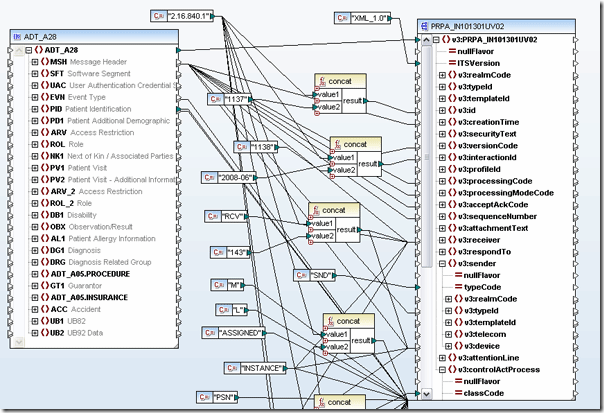 This will be our first opportunity to demonstrate the new Altova MissionKit 2010 Release 2 with significant speed and performance enhancements across the product line. Come see the new 64-bit versions for yourself, or download a free trial today. If you are one of the expected 30,000+ attendees traveling to Atlanta for HIMSS10, stop by and see us at booth 5744. Or click here to get more information on the Altova MissionKit and HL7.
This will be our first opportunity to demonstrate the new Altova MissionKit 2010 Release 2 with significant speed and performance enhancements across the product line. Come see the new 64-bit versions for yourself, or download a free trial today. If you are one of the expected 30,000+ attendees traveling to Atlanta for HIMSS10, stop by and see us at booth 5744. Or click here to get more information on the Altova MissionKit and HL7.
MapForce v2010r2 New Features
2010 has already been a very busy year at Altova, with our v2010r2 release now just three days old. Continuing on the Most Wanted theme of our v2010 launch, we have added several great new features to MapForce in response to customer requests (just in case you thought we weren’t listening) – but first let’s talk a bit about 64-bit versions. MapForce, and all of the other tools in the MissionKit, are now available in 64-bit versions for the same price as the 32-bit downloads (SMP subscribers can use their current keycodes for 64-bit versions). Customers running 64-bit operating systems will now be able to take full advantage of much faster processing speeds for integrating large files (100 MB+) in MapForce. For the developers, we have also added support for external C# and Java calls in mapping transformations, so that you can get an accurate preview of your mapping in the output window. We’ve also developed a new process for adding C# and Java libraries – by simply selecting the .NET assemblies of Java class files to import. For EDI specialists, we’ve added automatic generation of X12 997 functional acknowledgement messages to confirm message receipt or relay transaction errors. And… for everyone else, we’ve added three new string functions: tokenize, tokenize-regexp, and tokenize-by-length. As you can see, there’s a little something for everyone here, so download a free trial of MapForce today to check it out – or, if you have SMP, take advantage of your free upgrade!
And… for everyone else, we’ve added three new string functions: tokenize, tokenize-regexp, and tokenize-by-length. As you can see, there’s a little something for everyone here, so download a free trial of MapForce today to check it out – or, if you have SMP, take advantage of your free upgrade!
Release 2 of the Altova MissionKit 2010
New 64-bit Altova Tools
Release 2 of the Altova MissionKit 2010 is available in a 32-bit version as well as a new 64-bit version for users running operating systems such as Windows 7 (64-bit) and Windows Vista 64-bit. There are many advantages realized with 64-bit versions – more about these in subsequent posts – but the most significant is the reduction of limitations associated with working with XML files sized anywhere from 100 MB up to the gigabyte range. Of course, R2 is also delivered in 32-bit versions that include all of the new features described below. The 32-bit versions will run on both 32- and 64-bit operating systems. For all database-enabled MissionKit tools, support for IBM® iSeries® has been extended to include the latest version, 6.1. Database users also now have the option to connect via the pure ODBC API instead of using Altova’s native support for a particular database. The native database support generally provides more functionality, but there may be instances when the user prefers the pure ODBC API. A convenient dialog offers access to either communication method. Below are just a few highlights of the new release. See full details and screenshots.
For all database-enabled MissionKit tools, support for IBM® iSeries® has been extended to include the latest version, 6.1. Database users also now have the option to connect via the pure ODBC API instead of using Altova’s native support for a particular database. The native database support generally provides more functionality, but there may be instances when the user prefers the pure ODBC API. A convenient dialog offers access to either communication method. Below are just a few highlights of the new release. See full details and screenshots.
XMLSpy 2010 R2
In addition to a new 64-bit version, Release 2 of XMLSpy 2010 delivers optimizations for working with large files in Text View and Grid View, faster XML Schema-based validation, and long-awaited support for HTTPS in the SOAP client and SOAP debugger. R2 also delivers support for versioning on SharePoint® Server, so you can now read/write files on the CMS with full check out/check in functionality. XMLSpy has long provided royalty-free code generation based on XML Schemas in Java, C#, and C++ for Windows – and with v2010r2 you can also generate C++ for use on the Linux platform.
XMLSpy has long provided royalty-free code generation based on XML Schemas in Java, C#, and C++ for Windows – and with v2010r2 you can also generate C++ for use on the Linux platform.
More R2 Highlights
Adding to 64-bit versions across the product line are these new features:
Check out all the details.
Updates and Upgrades
Try Free
As always, you can evaluate any Altova product with access to full functionality for 30-days, free of charge.
Altova XBRL Resources
In the year since the Altova MissionKit 2009 added XBRL support as a marquee feature, we have added several new technical resources for anyone starting to learn the complexities of XBRL. Many of these are uniquely focused toward our present and future customers – those who are familiar with XML and the other components that contribute to the XBRL standard, but have no hands-on experience with XBRL itself. We invite you to comb through these resources and to learn, as we have learned, how this powerful and flexible language can promote transparency and interactivity in financial reports, transactions, and internal auditing practices. · XBRL: An Overview for Technical Users – a whitepaper catered toward developers and other technical users · XBRL Training – a free, online, 5-module course that provides an introduction to XBRL technology and the MissionKit · XBRL Glossary – a comprehensive list of the technical terms that are used in describing XBRL instance documents, XBRL taxonomies, and the XBRL specification in general · XBRL Solutions Page – a brief overview of the XBRL specification and the Altova tools that support it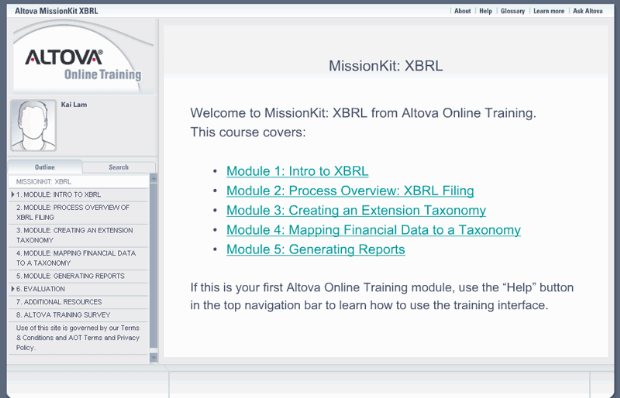
StyleVision Review and Video Demo
As the XML Aficionado reported over on his blog, Dave Gash recently published an in-depth review of Altova StyleVision 2010 on the WritersUA Web site. The review provides an excellent synopsis of how the StyleVision stylesheet and electronic forms design tool works and even covers some of the exciting new features in the recently released 2010 version, including absolute positioning, electronic forms design, blue print support, and more. Gash notes that StyleVision helps take the pain out of creating XSLT stylesheets to render XML or database data:
During the rest of the review, Gash walks through some common tasks (illustrated with screenshots) that users may accomplish using StyleVision and concludes:
Please check out the StyleVision review for all the details.
UPDATED: StyleVision Demo
To see a brief overview of the features highlighted in the review above, check out our Intro to StyleVision video demo, which has been recently updated to include new functionality in Version 2010. This three-minute video will give you a good idea of what you can accomplish with StyleVision. And when you’re ready to test drive StyleVision for yourself, grab a free trial from our Web site.
And when you’re ready to test drive StyleVision for yourself, grab a free trial from our Web site.
A Developer’s Life is Never Simple
Earlier this month in our blog post on Comparing XML Schemas we showed a realistic – but simplified – example to illustrate a slick new feature of DiffDog 2010 to compare XML Schemas and update corresponding XML data files by generating XSL transformations.

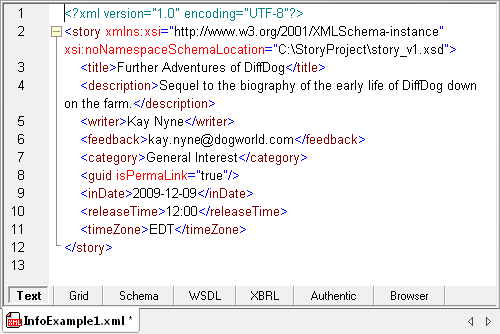
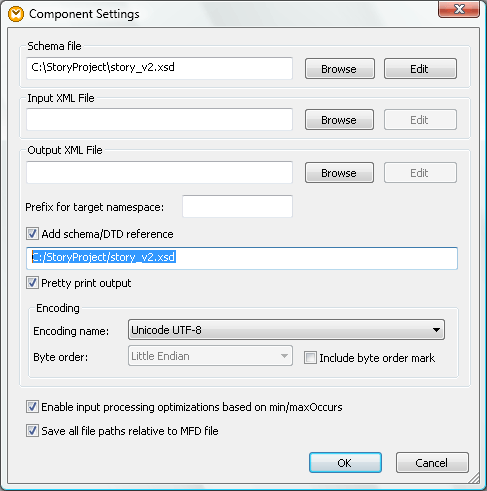

A real-life XML developer’s project is rarely as small and straightforward as the example we used. In this post we will take a look at some typical complications developers face every day and how the Altova MissionKit cuts through complexity to enhance productivity.
Longer XML Schemas and Larger Mappings
Your XML Schemas are not likely to be as short and simple as the ones in our earlier post, and you will likely want to save your work while you are mapping your XML Schema migration. DiffDog lets you save your mapping in an XML Schema comparison file that you can reload later to continue your work, or to share with a colleague.
If you need to compare two XML Schemas on a regular basis, the XML Schema Comparison Document can be a valuable time saver.
Embedded XML Schema Assignment
The screen shot below shows the XML data file from our original example with one important difference. In this version the story element includes an embedded reference to the XML Schema on line 2.
When we transform this file with the simple XSLT we created in DiffDog, the new XML data file will not include the updated XML Schema reference. In our earlier blog post embedded XML Schema references weren’t an issue because we used the XMLSpy Project / Properties menu option to assign default XML Schemas for each folder.
If there are many XML data files to transform, and they require embedded XML Schema references, we can take advantage of an additional feature of MapForce. We can export our mapping from DiffDog to MapForce, as we did in the earlier post, and then use the Component Settings dialog for the MapForce output component to include the XML Schema reference.
Document Your Work
Developers can lose productivity trying to retrace history when a project needs additional work months or even years after an early iteration. The MapForce Generate Documentation feature can help us avoid this frustrating experience.
MapForce will document the mapping of each element in the XML Schemas in Microsoft Word, RTF, or HTML formats. Regardless which format we choose, the resulting document is an excellent stand-alone project artifact, or it can be further edited and included in a larger report.
We can even combine the MapForce mapping documentation with full descriptions of each version of the XML Schema generated with the XMLSpy XML Schema Editor documentation feature.
Source/Version Control
Source/version control systems let teams of developers work closely together on the same project without a risk of overwriting each others’ changes. Because a version of the source code is saved at each stage of the design process, it is very easy to look at or revert to an earlier version when needed.
Altova has implemented the Microsoft Source Code Control Interface (MSSCCI) v1.1 – v1.3 in XMLSpy and tested support for many popular source control systems, so we can manage the files in our XML Schema evolution project across the development enterprise. Additionally, DiffDog can be integrated with source control systems as the default comparison tool. DiffDog can even generate differences report files in a variety of formats.
See for yourself how the tools in the Altova MissionKit can cut through the complexity of your own XML, Web Services, data integration, XML publishing, XBRL, and UML modeling development projects – download a free 30-day trial!
Curl up with a good book from the Altova library
Comparing XML Schemas with DiffDog 2010
DiffDog 2010 includes a powerful new tool to compare XML Schemas that XML developers and others can use to update existing XML data files as XML Schemas evolve. This post takes a look at an example scenario for this feature.Before we drop into the new functionality, let’s take a quick look at two XML Schemas using the DiffDog File Compare feature. Of course, just like in previous versions, DiffDog 2010 users can compare XML Schemas as .xsd documents and display differences in a color-coded, XML-aware format.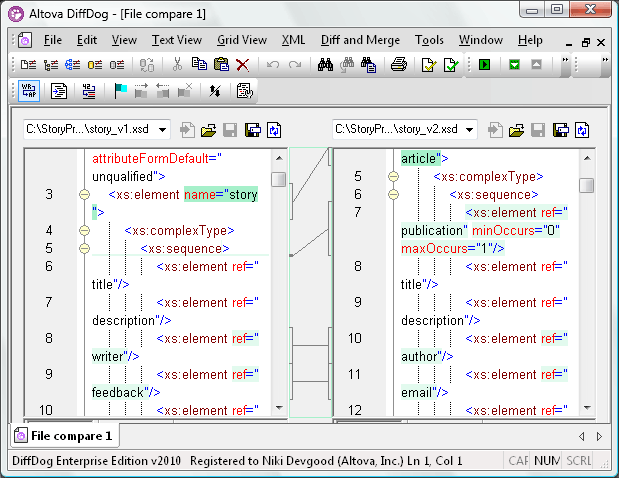 This is a good way to identify and manage differences in XML Schemas, especially when you want to review revisions to industry-standard XML Schemas that evolve over time.What’s new in DiffDog 2010 is an additional XML Schema Differencing option that graphically displays two XML Schemas side by side, identifies identical elements automatically, and lets users map differences and generate XSL transformations to update XML data files.Here’s our first view when we open the same two XML Schemas shown in the file comparison above, using the new XML Schema Differencing feature.
This is a good way to identify and manage differences in XML Schemas, especially when you want to review revisions to industry-standard XML Schemas that evolve over time.What’s new in DiffDog 2010 is an additional XML Schema Differencing option that graphically displays two XML Schemas side by side, identifies identical elements automatically, and lets users map differences and generate XSL transformations to update XML data files.Here’s our first view when we open the same two XML Schemas shown in the file comparison above, using the new XML Schema Differencing feature.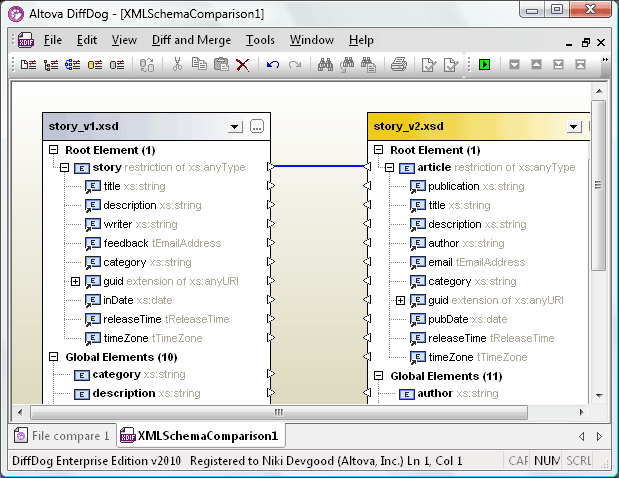 The root elements of the two XML Schemas are automatically connected. We can click the Compare button in the toolbar to automatically connect identical elements in the two XML Schemas.
The root elements of the two XML Schemas are automatically connected. We can click the Compare button in the toolbar to automatically connect identical elements in the two XML Schemas.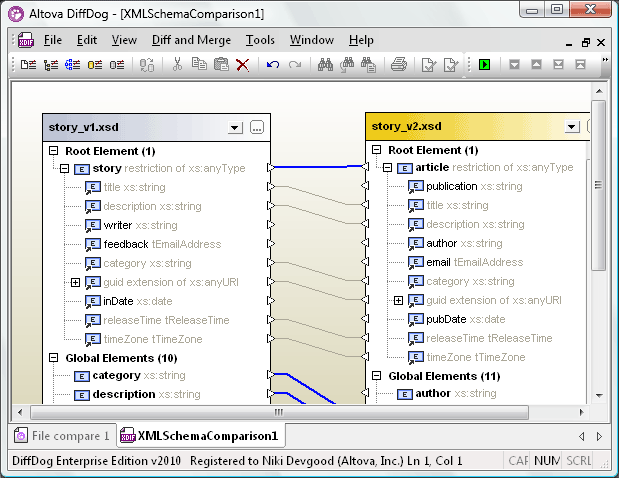 (Of course we could also select Compare XML Schemas from the right click context menu, or choose Start Comparison from the Diff and Merge menu, or press the F5 keyboard shortcut – DiffDog gives you many options to perform the same task, so you can work the way you like.)Next, we can map elements with different names in the two XML Schemas by manually connecting the pointer arrows between them. In this example most of the changes to the version of the XML Schema on the right simply give elements new names that will be more clear when the XML Schema and its data files are distributed through our enterprise.
(Of course we could also select Compare XML Schemas from the right click context menu, or choose Start Comparison from the Diff and Merge menu, or press the F5 keyboard shortcut – DiffDog gives you many options to perform the same task, so you can work the way you like.)Next, we can map elements with different names in the two XML Schemas by manually connecting the pointer arrows between them. In this example most of the changes to the version of the XML Schema on the right simply give elements new names that will be more clear when the XML Schema and its data files are distributed through our enterprise.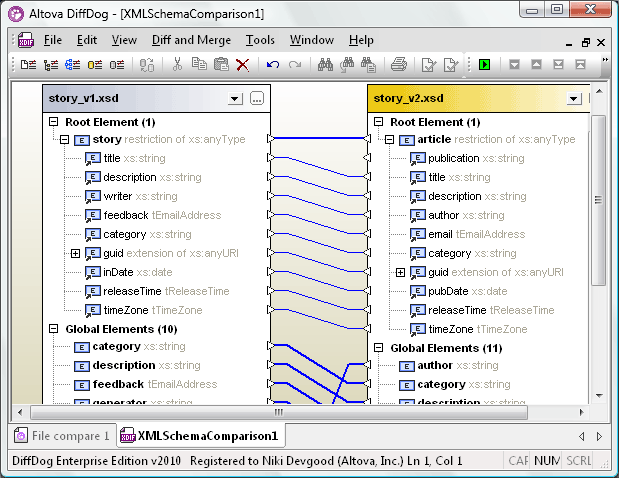 When all the elements are mapped, we can generate an XSLT file to transform existing XML data files based on the XML Schema on the left to reflect revisions in the newer version on the right. This feature is designed to rescue XML developers from the tedious tasks of writing and debugging XSL transformations by hand.
When all the elements are mapped, we can generate an XSLT file to transform existing XML data files based on the XML Schema on the left to reflect revisions in the newer version on the right. This feature is designed to rescue XML developers from the tedious tasks of writing and debugging XSL transformations by hand.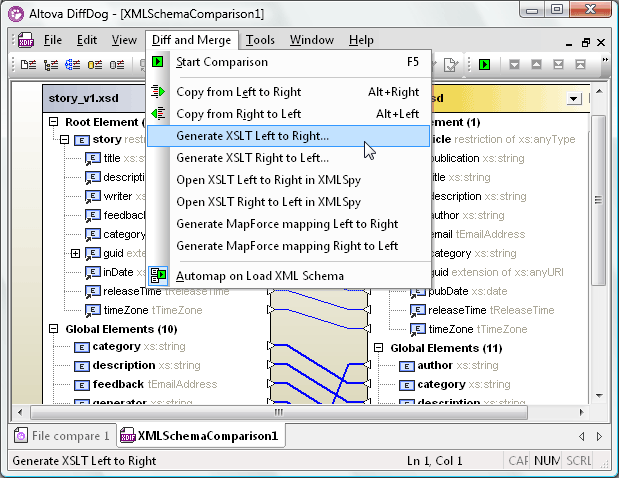 Here is an example of an original XML data file based on the XML Schema on the left side, as viewed in Altova XMLSpy:
Here is an example of an original XML data file based on the XML Schema on the left side, as viewed in Altova XMLSpy: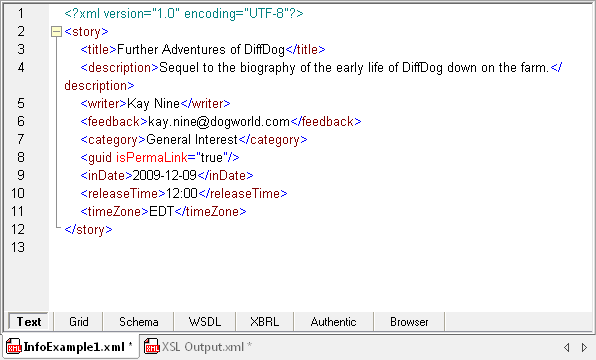 The output file after applying the XSL transformation we created with DiffDog 2010 appears below. Note the substitution of the author element for writer, email for feedback, and so on.
The output file after applying the XSL transformation we created with DiffDog 2010 appears below. Note the substitution of the author element for writer, email for feedback, and so on.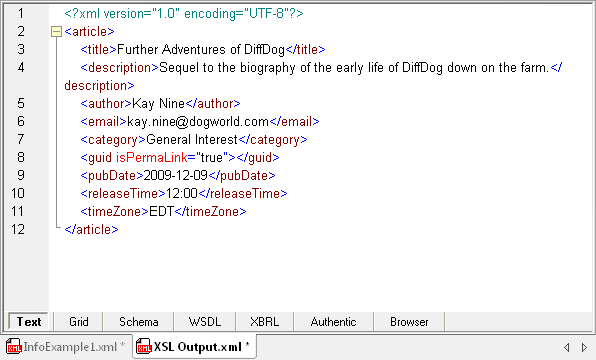 If there are many existing XML files that need to be transformed, the Project Management features of XMLSpy can help us automate the process. We can add external folders to an XMLSpy project.
If there are many existing XML files that need to be transformed, the Project Management features of XMLSpy can help us automate the process. We can add external folders to an XMLSpy project.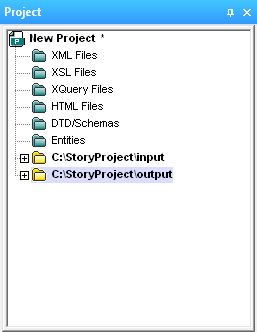 Using the XMLSpy properties dialog for each project folder, we can assign default values to assign an XML Schema for validation, the XSL transformation, and the destination of the output.
Using the XMLSpy properties dialog for each project folder, we can assign default values to assign an XML Schema for validation, the XSL transformation, and the destination of the output.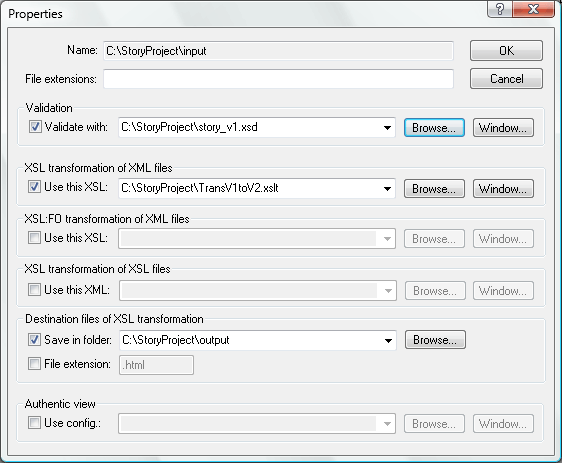 Now we can select the input folder in the XMLSpy Project helper window and transform all the files in it with the single-keystroke F10 shortcut.When we originally mapped the XML Schema elements in DiffDog, we left the publication element on the left side unconnected, since it had no corresponding element in the earlier version of the schema. That means when we transform XML input files using the XSLT, the resulting output will not contain the publication element. If publication is a required element, we can call on Altova MapForce for a quick solution.One of the options in DiffDog is to generate a MapForce mapping rather than XSLT. When we choose this option, MapForce launches with our DiffDog mapping already loaded as a new MapForce design, as shown below.
Now we can select the input folder in the XMLSpy Project helper window and transform all the files in it with the single-keystroke F10 shortcut.When we originally mapped the XML Schema elements in DiffDog, we left the publication element on the left side unconnected, since it had no corresponding element in the earlier version of the schema. That means when we transform XML input files using the XSLT, the resulting output will not contain the publication element. If publication is a required element, we can call on Altova MapForce for a quick solution.One of the options in DiffDog is to generate a MapForce mapping rather than XSLT. When we choose this option, MapForce launches with our DiffDog mapping already loaded as a new MapForce design, as shown below.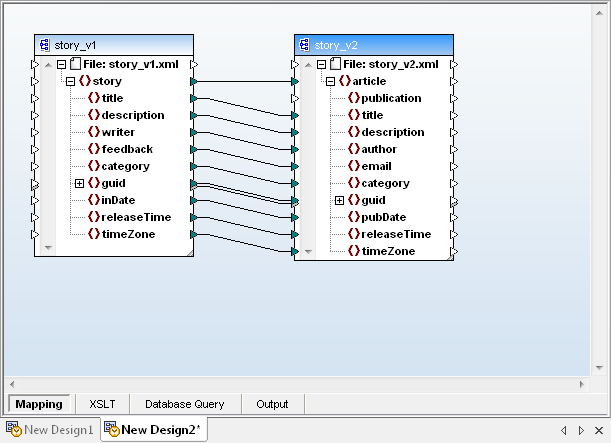 It’s easy to enhance the mapping by adding a constant as a default value for the publication element.
It’s easy to enhance the mapping by adding a constant as a default value for the publication element.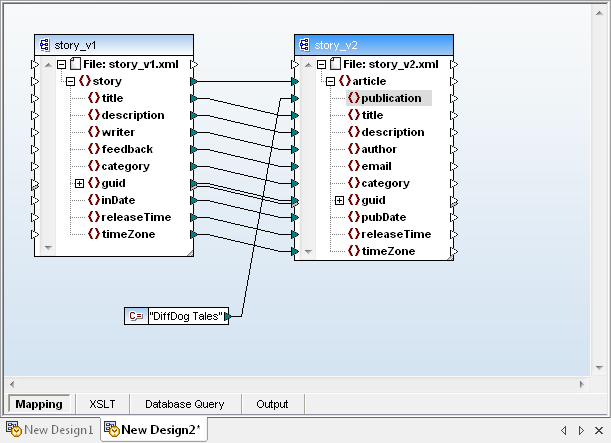 Now we can save an XSL file from MapForce that reuses all the element mappings we originally designed in DiffDog and adds the constant. When we apply the new XSL to transform our original XML data file, we get a result that includes the default value for the publication element.
Now we can save an XSL file from MapForce that reuses all the element mappings we originally designed in DiffDog and adds the constant. When we apply the new XSL to transform our original XML data file, we get a result that includes the default value for the publication element.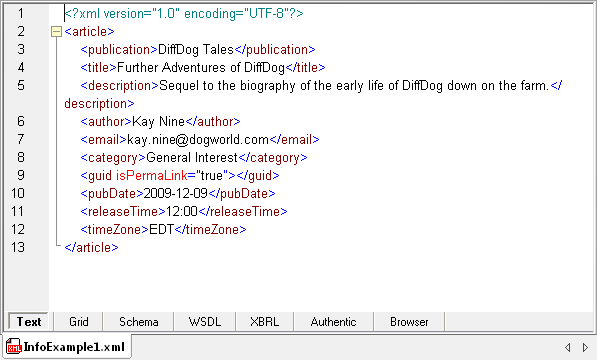 This post started by describing the new XML Schema Comparison feature in DiffDog 2010. Fleshing out a simple – but typical – real-world example quickly highlighted additional tasks easily completed by taking advantage of tight integration with XMLSpy and MapForce.All three of these tools and more are available at substantial savings in the Altova MissionKit 2010, the integrated suite of XML, database, and UML tools designed to meet the diverse development and data management needs of today’s software architects and XML developers. Click here to download a free trial today!
This post started by describing the new XML Schema Comparison feature in DiffDog 2010. Fleshing out a simple – but typical – real-world example quickly highlighted additional tasks easily completed by taking advantage of tight integration with XMLSpy and MapForce.All three of these tools and more are available at substantial savings in the Altova MissionKit 2010, the integrated suite of XML, database, and UML tools designed to meet the diverse development and data management needs of today’s software architects and XML developers. Click here to download a free trial today!
Report from Microsoft PDC
New in StyleVision v2010
Over fifteen new features, and they’re not small ones either, they’re the kind that a Marketing Manager has to write about. Several months ago I was groaning (inwardly, of course) about this. But the v2010 release is out, the StyleVision v2010 feature descriptions are written, and now I am genuinely excited to share with all of you the powerful functionality in the "Most Wanted" release. All of these features, I remind you, were directly requested by our customers either in person at the Altova tradeshow booth, or online via our Support Center or user forums – so please keep them coming! I will briefly outline some of the new functionality in StyleVision v2010 below, and make sure you look out for future posts where we will be highlighting specific features in all of the MissionKit tools in more detail. The best news of all though, is that we’ve just released the updated StyleVision online training that covers many of the new features in v2010. StyleVision is a unique tool for designing stylesheets and building reports based on XML and database data and simultaneously publishing them in HTML, RTF, PDF, Word 2007, and/or Authentic e-Forms. Completely new design paradigm To call this a "feature" simply doesn’t do it justice. The StyleVision user interface has been redesigned to give you an alternative method for how you structure your templates. Current users do not panic, this is just an option and you will still be able to use StyleVision in the way that you have learned to love. The rest of you, however, can now approach StyleVision in the same way you do common desktop applications, adding style first and content afterward. Templates can now be created within layout containers, and an optional blueprint image can be inserted as a design guide. Layout containers can: · Be inserted within document templates or encompass the entire document. · Inherit the dimensions of the document section or have user-defined dimensions. · Be assigned any number of style properties (borders, background color, font, etc.). · Contain a blueprint image to serve as a reference template for the design. True electronic form design through absolute positioning Absolute positioning in StyleVision coupled with the new design paradigm mentioned above lets you easily and precisely design templates for electronic forms. You can insert design elements like lines, boxes, text, etc. by specifying their x and y coordinates in the document section. Take a look at the example below – an I-9 form template based on an imported blueprint image – to see how this works.
Layout containers can: · Be inserted within document templates or encompass the entire document. · Inherit the dimensions of the document section or have user-defined dimensions. · Be assigned any number of style properties (borders, background color, font, etc.). · Contain a blueprint image to serve as a reference template for the design. True electronic form design through absolute positioning Absolute positioning in StyleVision coupled with the new design paradigm mentioned above lets you easily and precisely design templates for electronic forms. You can insert design elements like lines, boxes, text, etc. by specifying their x and y coordinates in the document section. Take a look at the example below – an I-9 form template based on an imported blueprint image – to see how this works.  Support for multiple page layouts in the same document This is an extremely important feature for anyone working with print formats in StyleVision where it is not uncommon to find pages with many different requirements in the same document. For example, you may need to intersperse pages of different sizes, landscape and portrait modes, different headers and/or footers, etc. You can now use document sections to specify different layout properties for your templates.
Support for multiple page layouts in the same document This is an extremely important feature for anyone working with print formats in StyleVision where it is not uncommon to find pages with many different requirements in the same document. For example, you may need to intersperse pages of different sizes, landscape and portrait modes, different headers and/or footers, etc. You can now use document sections to specify different layout properties for your templates.  Column formatting for print output formats Another great new feature for print output in StyleVision is the ability to add automatically formatted columns in template designs – columns that flow content from the bottom of one column to the top of the next.
Column formatting for print output formats Another great new feature for print output in StyleVision is the ability to add automatically formatted columns in template designs – columns that flow content from the bottom of one column to the top of the next.  Inline HTML, XSLT, XSL:FO processing commands And now let’s delve a little into the more technical new features in StyleVision… You can now insert processing commands at virtually any point in your design templates. This gives you the flexibility to call upon functionality that is not necessarily natively supported in StyleVision.
Inline HTML, XSLT, XSL:FO processing commands And now let’s delve a little into the more technical new features in StyleVision… You can now insert processing commands at virtually any point in your design templates. This gives you the flexibility to call upon functionality that is not necessarily natively supported in StyleVision.  Ability to import external XSLT files StyleVision now also allows you to import external XSLT files as part of their template designs. This adds an xsl:import statement to the StyleVision stylesheet and enables you to add your hard coded XSLT files to styles and other integrated features from the StyleVision design interface.
Ability to import external XSLT files StyleVision now also allows you to import external XSLT files as part of their template designs. This adds an xsl:import statement to the StyleVision stylesheet and enables you to add your hard coded XSLT files to styles and other integrated features from the StyleVision design interface.  Extension templates based on any XPath StyleVision now also supports the use of XPath wildcards: (*, node(), etc.) and the | operator, for example, can now be used for user-designed templates that can output a wide range of variable data based on the referenced XML source code. This allows for full flexibility in selecting nodes and values from any XML location and in any combination within your document(s).
Extension templates based on any XPath StyleVision now also supports the use of XPath wildcards: (*, node(), etc.) and the | operator, for example, can now be used for user-designed templates that can output a wide range of variable data based on the referenced XML source code. This allows for full flexibility in selecting nodes and values from any XML location and in any combination within your document(s).  Additional new features in StyleVision v2010 That is a brief list of my favorite new features from the StyleVision v2010 "Most Wanted" release, but we have also included many others such as: · Ability to print design templates · XHTML output option · Disable-output-escaping function · Ability to modify output DPI · Support for variables in design · Native code calls (.NET, Java, JavaScript, etc.) in XPath statements Download a free trial of StyleVision v2010 – or if you have active SMP, download your upgrade today!
Additional new features in StyleVision v2010 That is a brief list of my favorite new features from the StyleVision v2010 "Most Wanted" release, but we have also included many others such as: · Ability to print design templates · XHTML output option · Disable-output-escaping function · Ability to modify output DPI · Support for variables in design · Native code calls (.NET, Java, JavaScript, etc.) in XPath statements Download a free trial of StyleVision v2010 – or if you have active SMP, download your upgrade today!
Altova at Microsoft PDC
Just-in-Time StyleVision Training
Multiple new features and usability enhancements have been added to StyleVision® 2010 based on customer requests, and Altova Online Training has updated all StyleVision modules to help you take advantage of these improvements.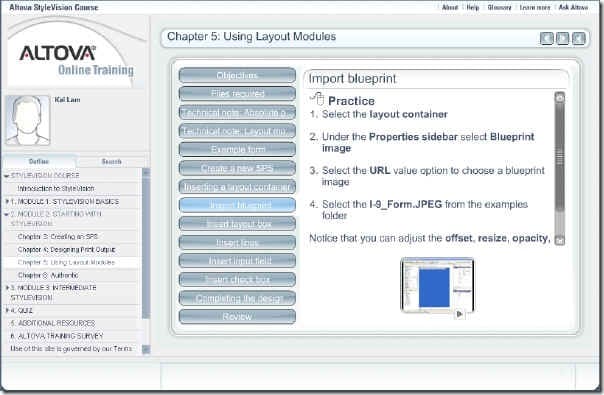 The beginner and intermediate level course begins with an introduction to the StyleVision interface and functionality as well as interactive tutorials for transforming XML and database content into eye-catching HTML pages, RTF documents, PDF reports, Word 2007 (OOXML) docs, and intuitive Authentic® forms. Module 2 builds on this foundation and provides detailed tutorials that will help you create an effective SPS file, design print output, use absolutely positioned layout modules, and create Authentic documents for users who would benefit from updating XML documents without seeing the underlying XML syntax. Module 3 introduces more advanced topics and includes step-by-step instructions on inserting auto-calculations, outputting XHTML, importing XSLT, disabling output escaping, setting DPI conversion factors, and using variables and user-defined templates and elements. Access the free StyleVision Course now.
The beginner and intermediate level course begins with an introduction to the StyleVision interface and functionality as well as interactive tutorials for transforming XML and database content into eye-catching HTML pages, RTF documents, PDF reports, Word 2007 (OOXML) docs, and intuitive Authentic® forms. Module 2 builds on this foundation and provides detailed tutorials that will help you create an effective SPS file, design print output, use absolutely positioned layout modules, and create Authentic documents for users who would benefit from updating XML documents without seeing the underlying XML syntax. Module 3 introduces more advanced topics and includes step-by-step instructions on inserting auto-calculations, outputting XHTML, importing XSLT, disabling output escaping, setting DPI conversion factors, and using variables and user-defined templates and elements. Access the free StyleVision Course now.
MapForce v2010 – “Most Wanted”
As a frequent attendee at the Altova booth at tradeshows, I have to say that this v2010 "Most Wanted" release has been one of my favorites since I’ve been with the company. Rather than centering the release around a marquee technology like we have in the past with XBRL, OOXML, etc., this time we have added to the MissionKit a collection of over 70 (not a typo) of the features that our customers have requested the most. Many of these requests have come directly from the tradeshow floor, and some I even recall scribbling down myself. Others have come from through our Support Center, and still more from Altova’s online user forums. So keep those requests coming, and we’ll keep on listening! In this post I’ll outline a few of the new features added to MapForce below, and be sure to look out for our future posts where we will spotlight individual features in more detail. Processing data from/into multiple files MapForce users have always been able to map data explicitly to and from many different components at the same time. This feature takes that ability much further, letting you implicitly process files, for example to/from a file collection or directory using a variety of different methods including wildcard values, database tables, auto-number sequences, and more. For example, the screenshot below shows files from a directory being mapped into a single target file using a wildcard (?) value. The output file generated from this mapping can be saved to any location from the Output Preview window. If you’d rather separate the output results into two separate XML files, you can just add a connection between the two file items at the top of each mapping component. Using file names as parameters As a complement to this functionality, you can now use file names as parameters in your mappings – an extremely useful feature for real-time transformations when this information may not be known until run time. In the example below, this is accomplished using an input parameter and connecting it to the file item node in the source mapping component.
The output file generated from this mapping can be saved to any location from the Output Preview window. If you’d rather separate the output results into two separate XML files, you can just add a connection between the two file items at the top of each mapping component. Using file names as parameters As a complement to this functionality, you can now use file names as parameters in your mappings – an extremely useful feature for real-time transformations when this information may not be known until run time. In the example below, this is accomplished using an input parameter and connecting it to the file item node in the source mapping component.  Support for WSDL 2.0 Like XMLSpy, MapForce v2010 has added support for Web services based on WSDL 2.0 in addition to WSDL 1.1. When you are building or connecting to Web services, MapForce automatically recognizes the syntax of WSDL 2.0 documents and applies appropriate processing rules.
Support for WSDL 2.0 Like XMLSpy, MapForce v2010 has added support for Web services based on WSDL 2.0 in addition to WSDL 1.1. When you are building or connecting to Web services, MapForce automatically recognizes the syntax of WSDL 2.0 documents and applies appropriate processing rules.  This feature gives MapForce users the flexibility to work with either version of the W3C format. A number of other features have been added to the "Most Wanted" release of MapForce including: · Support for xsi:type in XML Schema · EDI file validation in generated code · Support for additional EDIFACT messages So… be sure to download a free trial of MapForce v2010 – or if you have active SMP, download your upgrade today!
This feature gives MapForce users the flexibility to work with either version of the W3C format. A number of other features have been added to the "Most Wanted" release of MapForce including: · Support for xsi:type in XML Schema · EDI file validation in generated code · Support for additional EDIFACT messages So… be sure to download a free trial of MapForce v2010 – or if you have active SMP, download your upgrade today!
Altova Online Training is Out of Beta
Visit Altova at DevConnections
XMLSpy’s Most Wanted
WSDL 2.0 Support
In response to requests from from Web services developers, the graphical WSDL editor in XMLSpy 2010 now supports the latest version of the WSDL standard, WSDL 2.0. This adds to existing support for WSDL 1.1, giving you the choice of which version of the standard to work with. The WSDL editor automatically provides the correct editing environment for the version currently being utilized, and XMLSpy even provides one-step conversion capabilities for migration between WSDL 1.1 and 2.0. Since the XMLSpy WSDL editor uses a graphical interface (you can, of course, also work in Text View if you wish), you can easily visualize the structure of your WSDL document and edit it using drag-and-drop functionality and context-sensitive entry helpers, which offer the relevant choices based on the selected WSDL version.
Enhanced XBRL Functionality
Since we added support for XBRL validation and XBRL taxonomy editing in XMLSpy 2009, we’ve received excellent feedback from customers, including some feature requests that we were able to address in v2010. The new XBRL documentation generation capabilities of XMLSpy 2010 make it easy to generate comprehensive documentation – in RTF, MS Word, or HTML – for your XBRL taxonomies. Multiple options let you choose exactly what to include in the documentation, and the resulting output (snippet shown below) includes hyperlinked components for easy navigation.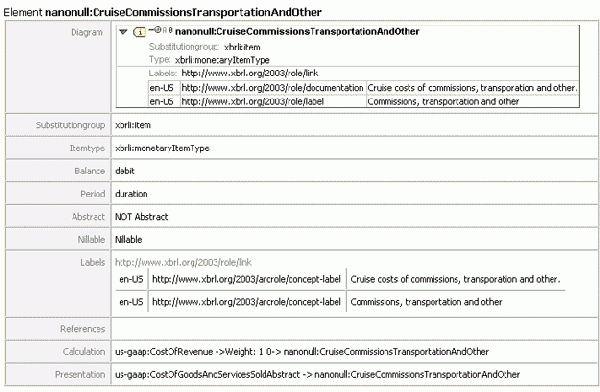
Another option for documentation is to print the graphical representation of your taxonomy as it is shown in XMLSpy’s graphical XBRL view. XMLSpy 2010 also includes the new XBRL Taxonomy Wizard to give you a head start when creating a taxonomy. Simply enter the company name, ticker, or other identifier for your XBRL taxonomy, and then select the base taxonomy to extend (if any).
XMLSpy creates the required taxonomy files and prompts you to select the entry points of the base taxonomy. Once you click finish, XMLSpy 2010 displays the newly created XBRL taxonomy files in the graphical XBRL Taxonomy Editor, where you can continue editing and refining the taxonomy in a visual manner. The new Find in XBRL and XBRL Sort options in XMLSpy 2010 meet customers’ requests for quick, easy ways to find data in and
navigate through large, complex XBRL taxonomies.
JSON Editor
We’ve recently heard from a lot of developers working on Web 2.0 and Web services apps in XMLSpy who also use JSON – so we decided to add a JSON editor in XMLSpy 2010. You can compose JSON strings in Text View or Grid View, and even convert between XML and JSON. In Text View, the JSON editor provides syntax coloring, line numbering, source folding, bookmarking, and more, making it easy to comprehend and navigate your JSON code, and find and edit strings. Intelligent JSON editing populates the Elements entry helper window with a dynamically built list of the elements present in your JSON file, which you can insert with a double-click.
Intelligent JSON editing is also available in Grid View, which provides graphical representation that shows the structure / outline of a JSON document through a set of nested containers. These can be easily expanded and collapsed to get a clear picture of the document’s tree structure, and drag-and-drop editing is supported.
Redesigned Scripting Environment & Forms Editor
XMLSpy includes an integrated scripting environment and forms editor that has been redesigned for this latest release. Scripts can be written in JScript or VBScript to access and interact with the XMLSpy API, allowing you to modify and add functionality to your installation of XMLSpy 2010. Improvements and optimizations in Version 2010 include:
Read more about the “most wanted” features in XMLSpy and the rest of the Altova MissionKit. Please be sure to let us know your most wanted features, either by commenting here on the blog or entering a feature request.
Altova’s Most Wanted Edition – Version 2010 Announced
We are excited to have launched the MOST WANTED edition of the Altova MissionKit today! The MissionKit 2010 represents the most wanted functionality as reported by you! We’ve wrangled over 70 new features into this version of Altova’s XML, database, and UML product line to deliver on your list of demands. Check out the highlights for each product included in the MissionKit 2010 tool suite below; subsequent posts will cover the new features in each product in greater detail.
WSDL 2.0
One of the features most often asked for is support for the latest version of WSDL: WSDL 2.0. In addition to existing WSDL 1.1 editing and validation capabilities, XMLSpy now supports WSDL 2.0 in the graphical WSDL editor. It also allows one-click conversion between WSDL 1.1 and 2.0 files.
WSDL 2.0 support has also been added to version 2010 of the MapForce data mapping tool, allowing you to connect to WSDL 2.0 (or 1.1) Web services and integrate their functionality into mappings of XML, databases, flat file, EDI, Excel 2007, and XBRL data. You can also use MapForce to build new Web services based on WSDL 2.0 definitions. MapForce 2010 delivers a number of other enhancements for data mapping, conversion, and integration.
XBRL Enhancements
Several new features for working with XBRL have been added in version 2010. XMLSpy includes a new XBRL Taxonomy Wizard for getting a head start creating taxonomies in the graphical XBRL Taxonomy Editor. You can also now generate comprehensive documentation for your XBRL taxonomies, or simply print the graphical XBRL representation. Find and sort capabilities let you work more easily with large, complex taxonomies.
If you’re not familiar with the extensive support for working with XBRL in the Altova MissionKit, check out the XBRL Solutions Center page.
JSON Support
With more and more developers working with JSON in the XML, AJAX, and Web services apps they’ve created in XMLSpy, we’ve received a lot of inquires about JSON support. Now you can edit your JSON files directly in XMLSpy, using Text View or the graphical Grid / Tree View with intelligent JSON entry helpers. XMLSpy even supports one-click JSON <=> XML conversion. Check out the rest of the features most desired by XMLSpy users.
New Design Paradigm in StyleVision
The StyleVision graphical stylesheet design / single source publishing tool now gives you a new, flexible option for designing stylesheets and electronic forms. The new design paradigm lets you create templates within layout containers, and even optionally upload a blueprint image on which to base your design. This way, you can specify your design first and add XML and/or database content after.
This new form-based design option is made possible by new support for absolute positioning in design layouts. Instead of having content and layout elements flow on the page automatically, like a typical web page layout, you can now specify exact X and Y coordinates for each element to absolutely position it on a page. This feature gives you more control over form design in the manner of desktop publishing applications, but also adds the powerful single source publishing capabilities for XML, XBRL, and database data that have always been present in StyleVision. Read about the numerous other enhancements in StyleVision 2010. Authentic 2010 users will directly benefit from many of the new StyleVision features for true electronic forms design described above. The sophisticated e-Forms created in StyleVision 2010 are presented in Authentic’s WYSIWYG-interface for XML and database content editing by non-technical business users. In addition, with the release of Version 2010, Authentic is now offered in Enterprise and Community Editions, both of which are available as either as a desktop application or browser plug-in. The new Authentic 2010 Enterprise Edition requires a paid license and provides advanced features for WYSIWYG XML and database content editing. Authentic 2010 Browser Plug-in Enterprise Edition is offered on a 12 month license term basis. Authentic 2010 Community Edition is available under a free license and is also offered in desktop and browser plug-in versions.
SysML Support
Altova’s affordable UML modeling tool has become even more robust with support for SysML, which is related to UML but optimized for designing software to operate and control embedded systems and other complex devices. UModel 2010 supports all SysML v1.1 diagram types and elements with all the same productivity-enhancing features available for UML and BPNM modeling, including code generation in Java, C#, and Visual Basic.
Read about all the new features in UModel 2010.
New Diff/Merge Capabilities
Both DatabaseSpy and DiffDog have received some exciting and oft-requested new diff/merge features in version 2010. DatabaseSpy, the highly-affordable, multi-database query, design, and comparison tool now allows you to compare and merge database schemas between databases of the same type or across different database types (all major relational databases are supported). DatabaseSpy displays differences between database schemas in a graphical manner, and you can generate a change script to merge changes in either direction.
DatabaseSpy 2010 also adds the ability to convert database structures between different database types, for example, to migrate from MySQL® to Oracle® or SQL Server®. Version 2010 of the DiffDog diff/merge tool for files, directories, and databases includes functionality similar to DatabaseSpy for comparing and merging database schemas, and it also provides the most wanted XML Schema diff feature. Since XML Schemas are ever-evolving as requirements change, existing XML files often also need to be updated to remain valid. You can now compare two XML Schemas graphically in DiffDog 2010, and then DiffDog will generate an XSLT file to transform any related instance documents according to the new schema. Alternatively, you can choose to generate an Altova MapForce mapping file based on the DiffDog comparison to further refine the transformation
between schemas.
Collect your Handsome Reward
If you’re an Altova customer with active Support and Maintenance Package, simply download and install version 2010, and your existing key code will activate the new version. New customers can download a free, fully-functional 30-day trial to start working with all these new features today.
What to Do On a Rainy Day in San Francisco?
That was the question for 30,000-plus attendees at Oracle OpenWorld 2009 last week, when weather forecasters were predicting the remnants of a Pacific typhoon would hit San Francisco with winds up to 60 miles per hour and drop rainfall measuring multiple inches. Fortunately, the best attractions were all indoors. Oracle OpenWorld is one of the largest events held each year at the Moscone Convention Center. The keynote speeches, conference seminars, and partner exhibitions fill all three buildings. Even Howard Street between the North and South halls is closed for an entire block to create room for the lunch pavilion. Oracle OpenWorld is the best place to come for face-to-face education and interaction on all subjects related to every facet of the Oracle ecosystem. Altova is an Oracle Partner and this is an event we look forward to every year. The Altova MissionKit provides extensive support for database management, query, and design; database integration; database differencing; and database content editing.
Fortunately, the best attractions were all indoors. Oracle OpenWorld is one of the largest events held each year at the Moscone Convention Center. The keynote speeches, conference seminars, and partner exhibitions fill all three buildings. Even Howard Street between the North and South halls is closed for an entire block to create room for the lunch pavilion. Oracle OpenWorld is the best place to come for face-to-face education and interaction on all subjects related to every facet of the Oracle ecosystem. Altova is an Oracle Partner and this is an event we look forward to every year. The Altova MissionKit provides extensive support for database management, query, and design; database integration; database differencing; and database content editing.  We love to meet users whose Oracle databases contain XML and show off features like support for Oracle XML DB data modeling, and the XQuery editor, debugger, and profiler in XMLSpy. We love to talk to users whose Oracle databases don’t contain XML yet, so we can demonstrate how to derive an XML Schema from the tables and relationships in a non-XML database. We also like to meet users who sometimes interact with databases other than Oracle, since the database functionality in Altova tools is never restricted to a single database technology. Due to the Oracle acquisition of Sun this year, MySQL was a popular subject. Our DatabaseSpy demo in the Altova booth highlighted simultaneous connections to Oracle and MySQL databases with interactive functionality to compare and merge data between tables in different database types. With convenient shuttle service from all the area hotels to Moscone, the question became not “What to do in the rain?”, but “What to do first?” Conference sessions covered every topic from databases to applications, to middleware, to specialized industry topics, and even XBRL. In Moscone West the Oracle Demo Grounds were always busy, with dozens of individual stations simultaneously active. The Altova booth was a popular spot, as were displays by other Oracle partners, including Amazon, Salesforce, and many more. To refresh and recharge, there were lots of fun things to do too. We even saw evidence that Paul and Ringo might have been there.
We love to meet users whose Oracle databases contain XML and show off features like support for Oracle XML DB data modeling, and the XQuery editor, debugger, and profiler in XMLSpy. We love to talk to users whose Oracle databases don’t contain XML yet, so we can demonstrate how to derive an XML Schema from the tables and relationships in a non-XML database. We also like to meet users who sometimes interact with databases other than Oracle, since the database functionality in Altova tools is never restricted to a single database technology. Due to the Oracle acquisition of Sun this year, MySQL was a popular subject. Our DatabaseSpy demo in the Altova booth highlighted simultaneous connections to Oracle and MySQL databases with interactive functionality to compare and merge data between tables in different database types. With convenient shuttle service from all the area hotels to Moscone, the question became not “What to do in the rain?”, but “What to do first?” Conference sessions covered every topic from databases to applications, to middleware, to specialized industry topics, and even XBRL. In Moscone West the Oracle Demo Grounds were always busy, with dozens of individual stations simultaneously active. The Altova booth was a popular spot, as were displays by other Oracle partners, including Amazon, Salesforce, and many more. To refresh and recharge, there were lots of fun things to do too. We even saw evidence that Paul and Ringo might have been there.  Best yet, when we stepped outside after a long, productive day, the rain had stopped and we were presented with a warm San Francisco night. Check out our Oracle Openworld 2009 video slideshow on YouTube to see more:
Best yet, when we stepped outside after a long, productive day, the rain had stopped and we were presented with a warm San Francisco night. Check out our Oracle Openworld 2009 video slideshow on YouTube to see more: